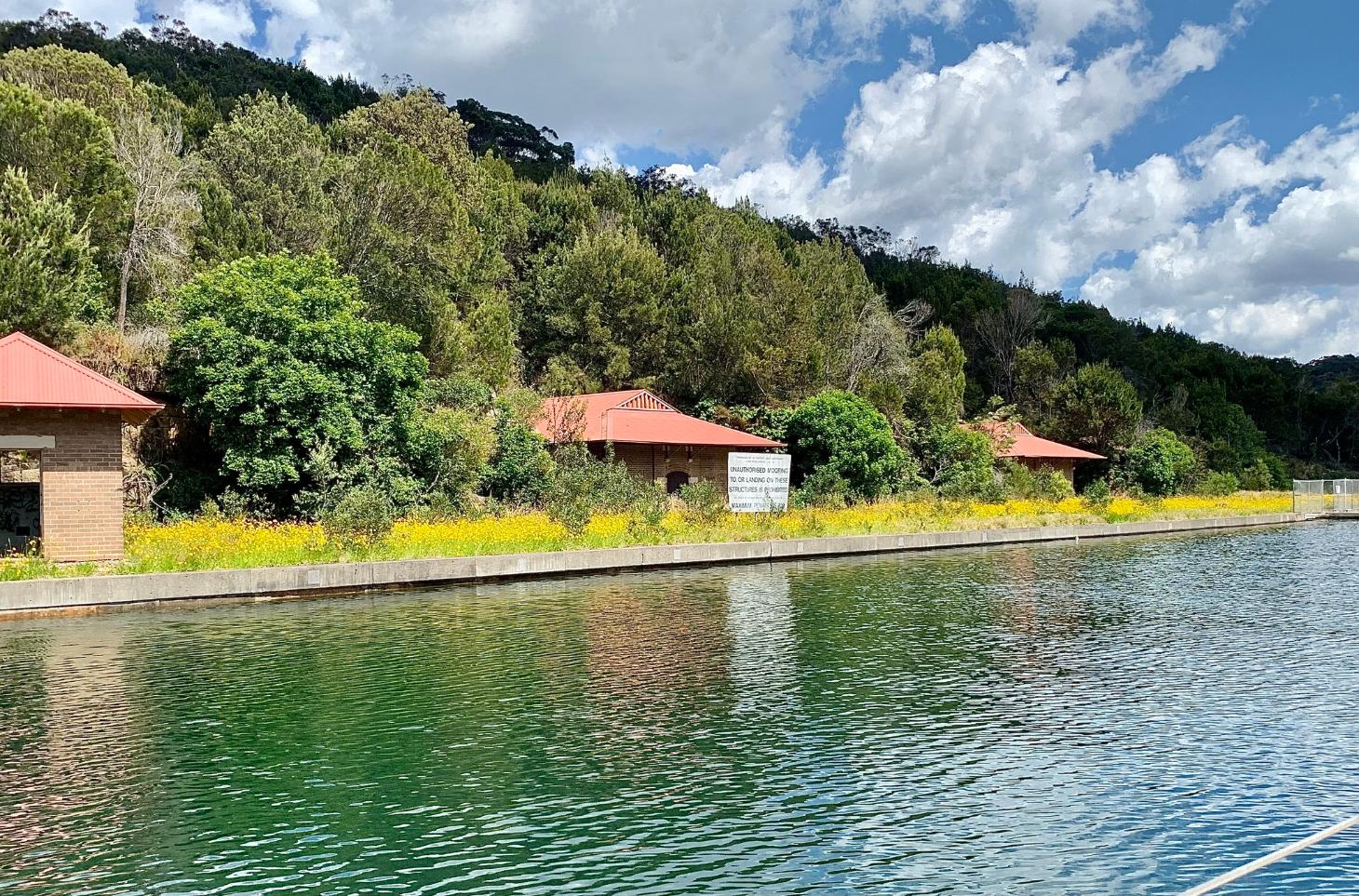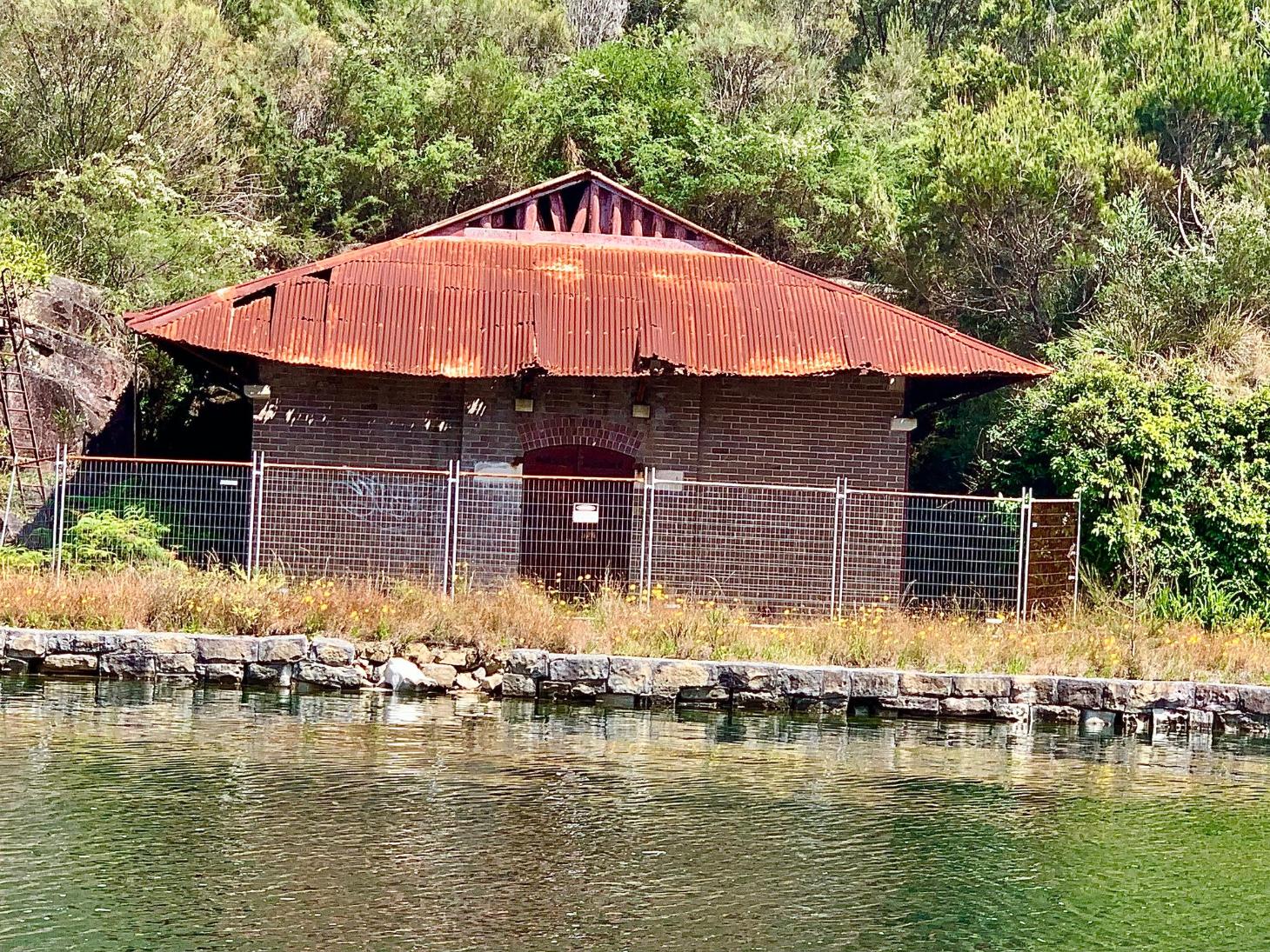Historic Heritage listed Bantry Bay Explosives Depot at middle harbor falling into disrepair from long neglect
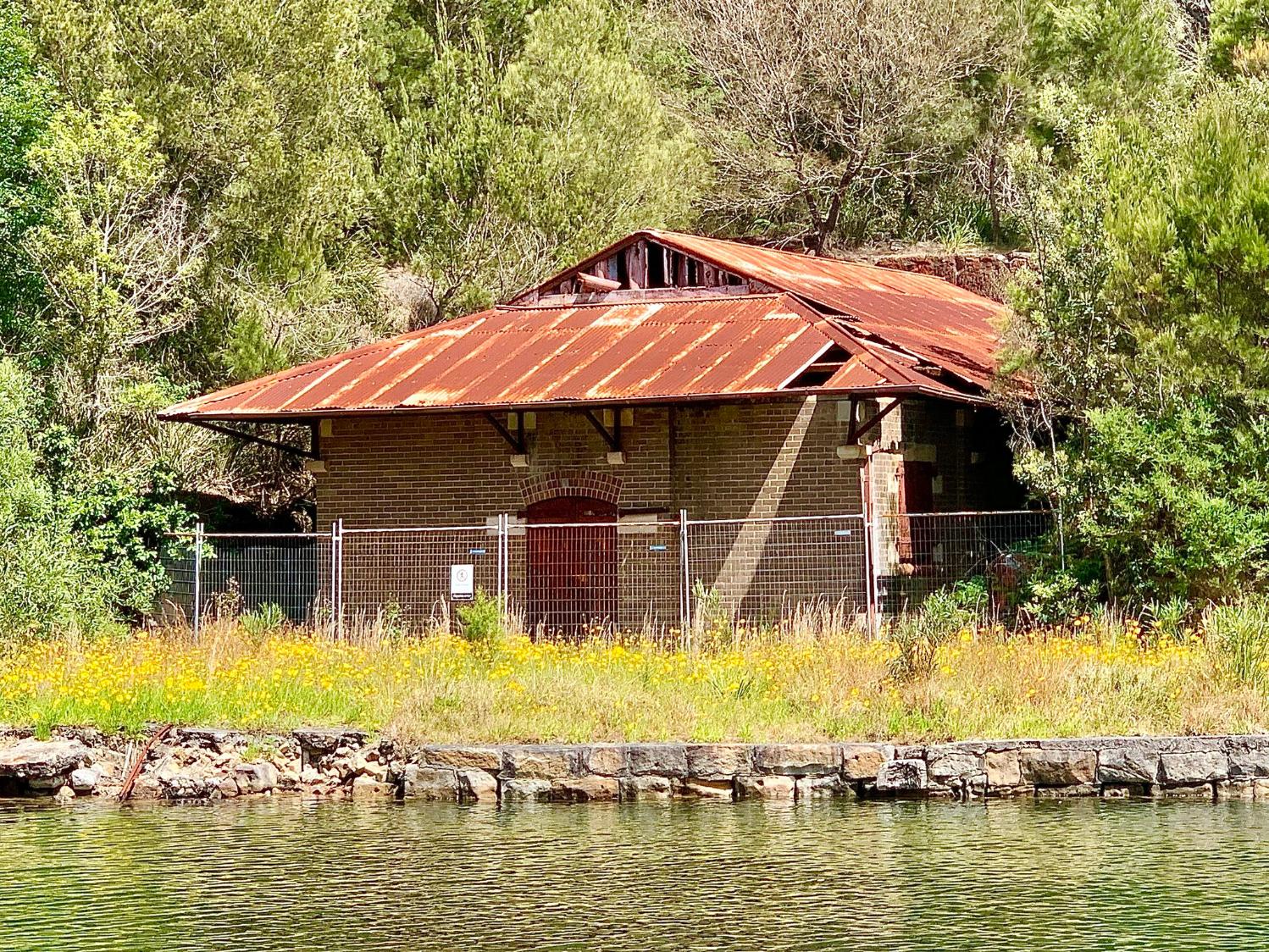
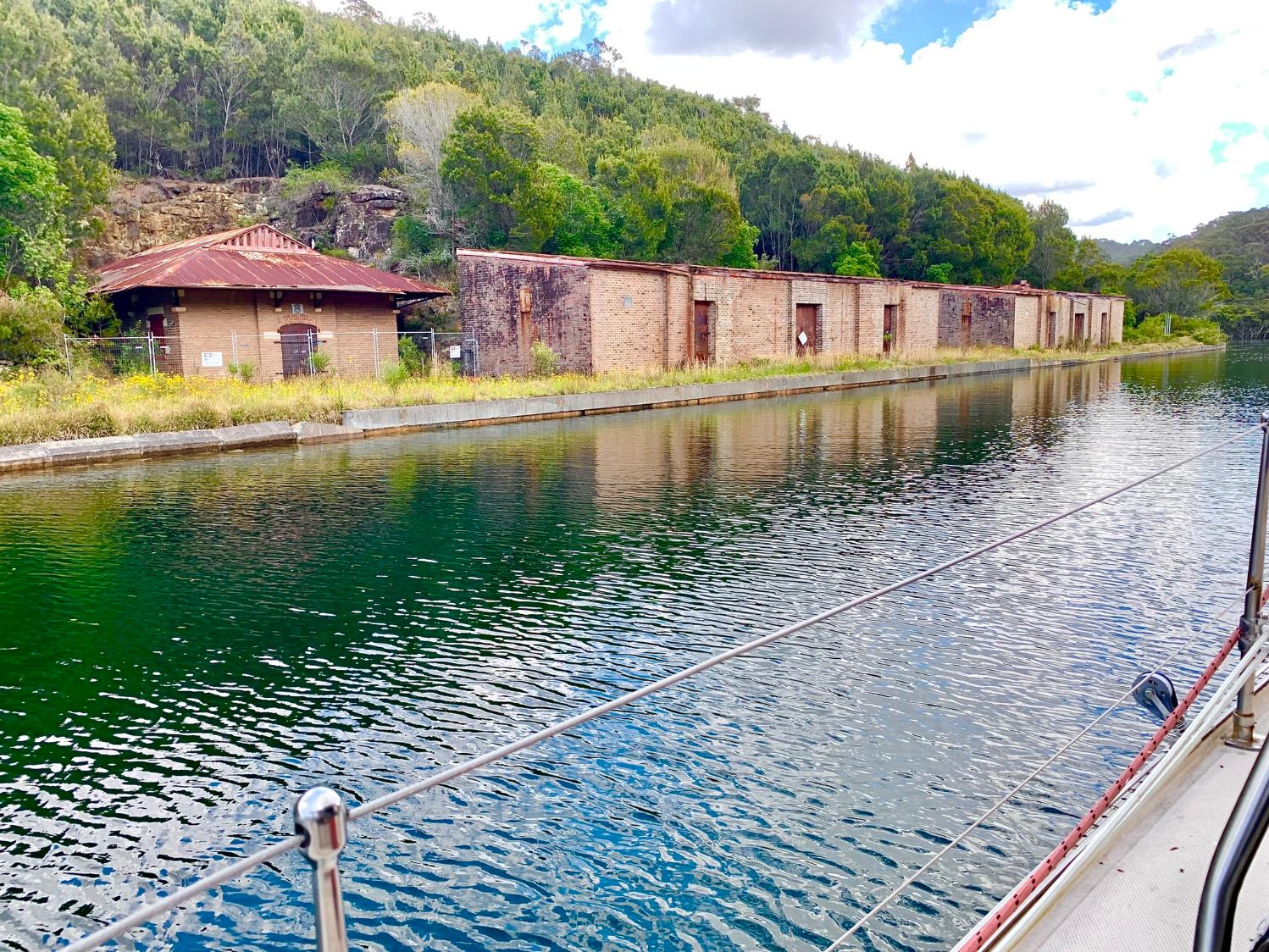
If the readership of history pages run in this news service is any indication, local, national and international readers have a strong interest in and passion for the historic backgrounds and heritage listed artefacts and buildings that encompass this area.
Several months ago, one of Pittwater Online’s Middle Harbor readers sent in distressing images of the Heritage listed Bantry Bay Explosives Depot, whose buildings are falling into disrepair.
Bantry Bay Explosives Depot was listed on the New South Wales State Heritage Register on April 2nd 1999. It is a unique example of integrated handling and storage facilities for explosive materials, and also provides more insights into our shared past than may seem apparent.
While Barrenjoey’s cottages may have been neglected for years due to a planned ‘repurposing’ upgrade that would have installed the 21st century over the 19th, despite assurances to the local residents association that they were being fixed, the reply to incessant queries by the reader was that there was simply no money to maintain these under the past NSW Government.
This is another historic local site and buildings that is being lost on our watch.
Dear Editor -
BANTRY BAY HERITAGE BUILDINGS CLOSE TO CATASTROPHE.
Sadly today these heritage listed buildings are under threat of bushfire overgrown by undergrowth and destruction by gross neglect. Here are recent photographs of some of the buildings. Note the roof is no longer waterproof in some cases.
Given a federal budget will soon be announced, and the newly voted in NSW Labor government has expressed throughout its years in opposition its plans to look after both our indigenous heritage sites, historic sites as well as historic environment, those who are still speaking up for the proper custodianship of this site may yet be heard.
As a destination for pleasure trips, Bantry Bay in Middle Harbour was popular from the 1870s onwards. In October 1880, for example, the tranquillity was shattered when 600 Sunday School scholars from Glebe descended on the area for their annual picnic.
In March 1891 it was the turn of the Railway Signalmen:
RAILWAY SIGNALMEN'S PICNIC. (1891, March 23). The Australian Star (Sydney, NSW : 1887 - 1909), p. 7. Retrieved from http://nla.gov.au/nla.news-article228170600
The Illustrated Sydney News sang that as a picnickers’ rendezvous, “When nature and ‘glorious Apollo’ behave their best, it is a veritable scene of landscape enchantment.”
Conveniently for trippers, there was a wharf at Bantry Bay, put there in the 1860s by James Harris French (who gave his name to Frenchs Forest). Mr. French used the wharf for shipping out timber cut at his two sawmills in the ‘Big Forest’.
On October 6th 1879, the NSW Government reserved over 640 acres of land for public recreation around Bantry Bay, much of which went to form the later gazetted Garigal National Park. This increased the attraction of “this most romantically situated spot.”
Department of Lands,
Sydney, 6th October, 1879.
RESERVES FROM SALE FOR PUBLIC RECREATION GROUND AT MIDDLE HARBOUR.
HIS Excellency the Governor, with the advice of the Executive Council, directs it to be notified that, in pursuance of the provisions of the 4th section of the Crown Lands Alienation Act of 1861, the land specified in the Schedule appended hereto shall be reserved from sale for public recreation ground.
JAMES HOSK1NS.
No. 40. County of Cumberland, parish of Manly Cove, area about 43 acres, Bantry Buy, Middle Harbour. The Crown Lands within, the following boundaries: Commencing on the eastern shore of Bantry Bay, at a north-west corner of J. W. Bligh's 61 acres; bounded on the south by a north boundary of that land east until it meet the southerly prolongation of the west boundary of J. W. Bligh's 30 acres ; on the east by a line partly forming a west boundary of J. W. Bligh's 61 acres and the west boundary of J. W. Bligh's 30i acres north to the south boundary of J. C. Rutter's 10 acres; on the north by a line forming part of that south boundary and the south boundary of J. W, Bligh's 12 acres and 12 acres, west to Bantry Bay and thence on the west by part of the eastern shore of that bay southerly, to point of commencement. [Ms. 79-11,239]
No. 41. County of Cumberland, parish of Manly Cove, area about 600 acres, Bantry Bay, Middle Harbour. The Crown Lands within the following boundaries: Commencing on the eastern shore of Bantry Bay, at the north-west corner of J. W. Bligh's 12 acres; bounded on part of the south by the north boundary of that land and the north boundary of J. W. Bligh's 12f acres, bearing east to the northeast corner of the latter land ; thence on part of the east by part of the western side of the road forming the western boundary of J. C. Butter's 10 acres, 14£ acres, 10 acres, and H. Lane's 10 acres, northerly to Catherine James' 5 acres} thence on part of the north by the south boundary of that 5 acres west to its south-west corner; on the remainder of the east by a line forming partly the western boundary of that land and J. Hold's 6 acres, north to the south boundary of J. H. French's 41 acres 12 perches ; on the remainder of the north by a line forming part of that boundary and the south boundary of J. Beard's 41 acres 12 perches, west to n point due north of the north-west corner of J. L. Spencer's 125 acres ; thence on the west by a line south to that corner ; on the remainder of the south by the north boundary of J. L. Spencer's 125 acres aforesaid easterly to Bantry Bay; and by the shore of Bantry Bay easterly, to point of commencement. [Ms. 79-11,239] RESERVES FROM SALE FOR PUBLIC RECREATION GROUND AT MIDDLE HARBOUR. (1879, October 6). New South Wales Government Gazette (Sydney, NSW : 1832 - 1900), p. 4435. Retrieved from http://nla.gov.au/nla.news-article223121726
Throughout the 1890s, an increasing number of excursions made Bantry Bay and the nearby Flat Rock their destination. Often the employees of a business, or members of a society would travel in a large crowd, have a picnic, some games and dancing, and usually have a few speeches when the food was being enjoyed.
The hills around Bantry Bay were covered in large trees, with one later article referring to what it calls the 'Middle Harbor Pine', which is described as being unique to this area and not seen elsewhere:
THE MIDDLE HARBOR PINE.
Conspicuous among the trees around Middle Harbor, on account of the exceptional darkness of its foliage, is the Middle Harbor pine, which stands out in pleasing contrast, of color and contour, to the trees around. It is said to be peculiar to this part, and hence its local name.
But it, along with the other timber near the foreshores, suffers equally with the flowers, though from another reason. Parties of inexperienced youth let loose in these solitudes, proceed to pull or cut down saplings for ridge poles for their tents, and all sorts of timber for their fires. Plenty of dry wood is available, but they seem to prefer showing their ignorance by trying what is green, and full of sap, and thus are they slowly, but surely, denuding the foreshore heights, which, unless measures are taken to preserve them, will in the course of a few years be universally bare and unsightly, as they already are in several places most frequented.
... How to Do Sydney. SIGHTS OF INTEREST IN AND AROUND THE CITY AND THE BEST MEANS OF SEEING THEM. V - MIDDLE HARBOR. ., (See illustrations on page 33.) (1900, December 22). Australian Town and Country Journal (Sydney, NSW : 1870 - 1919), p. 29. Retrieved from http://nla.gov.au/nla.news-article71387272
These tall splendidly ancient trees attracted wood cutters and the pioneer of the area, James Harris French who later gave the suburb of French’s Forest its name. Mr. French was a Constable and Crown Lands Ranger who arrived in the area in 1856. He acquired 46 acres of land above Bantry Bay and established the first local timber industry.
Access to and from Bantry Bay was mostly by water, but around 1855 a road was cut from Bantry Bay Road to the eastern shore of the bay. Some have opined that French used his influence as Crown Lands Ranger to have the road constructed at Government expense. French’s sawmill cut and split timber on the hills above the bay and then dragged it down to Bantry Bay by bullock team. From the wharf on the eastern shore it was shipped to the Harbour for sale.
Today, the Wakehurst Parkway follows the route of the old road along the top of the ridge. Correspondence from the Secretary for Lands and Public Works in 1856, indicates that a wharf had been erected, probably to serve the saw millers, at the end of the track. The Old Bullock Track still exists in parts with cobbles, culverts and the remains of a stone bridge, and the reclaimed area at the end of the track was probably the base of the wharf.
The pattern of settlement in the bay, apart from the Walters family, was seasonal occupation and exploitation. The circa 1856 plan from the Department of Lands, which illustrates the eastern shore and indicates the line of Bantry Bay Road (present Wakehurst Parkway), shows a camp situated on the eastern shore of the bay above the present wharf and the resumption of land for the Old Bullock Track.
The camp was most likely the seasonal camp of oystermen, fishermen or timber cutters. Fresh water was found in the narrow gully to the north of the campsite, with a fast flowing stream of fresh water.
The area was certainly occupied by Aboriginal people on a seasonal basis, if not year round. Lime burners would have been attracted by the shell deposits/mounds of middens which generations of Aboriginal people left behind.
However, after 1788, there is little or no mention of Aboriginal populations in Middle Harbour. After the smallpox epidemics, many Aboriginal people in Port Jackson moved to areas where they could continue to hunt and gather, away from the Europeans. Large groups went to the Hawkesbury area, and later La Perouse, Leichhardt and Redfern. Middle Harbour and its suburbs do not appear to have been a popular site for Aboriginal families and groups to reside, even though there was no permanent agricultural settlement here and there are still sacred sites within the area.
As a recreation area, Bantry Bay and Middle Harbor, although not as popular as Clontarf or Clifton Gardens, or even an 'excursion to Pittwater' still attracted thousands of visitors.
The New Balmain Ferry Company built a dance hall, terraced picnic ground, a dining room, several summer houses, a caretakers cottage and a large number of tanks to provide fresh water, on 12 acres of land which they owned on the eastern shore. The entrepreneur, John Dunbar Nelson had begun a number of Middle Harbour ferry trips sometime around 1895. An advertisement from 1904 listed excursions to Balmoral Beach, Pearl Bay, Bantry Bay and Flat Rock. For a sixpence ticket the excursionists could land at any of the designated stops while at Pearl Bay and Bantry Bay there was the addition of “ Swings and Merry-go-rounds, Summer houses and Shady nooks, also Dancing and Dining Pavilions.”18 The ferries were provided with a band and the scenery was described as the ‘Killarney of Australia’, which added to the sentimental romance of the place.
John Dunbar Nelson was Irish, and although the naming of Bantry Bay had occurred long before 1856, he was happy to exploit any sentimental connections. Bantry Bay is named after a bay on the south coast of County Cork, Ireland, where the English battled with the French over their defence of Irish Catholicism in the 18th century. This, for the Irish at least, must have added to the romance of the place.
To attract patrons to the ferry services, Nelson’s company advertised the pleasure resorts as providing rural seclusion, grandeur of scenery and “all the conveniences and attractions requisite to a 20th century pleasure resort”. The advertising pamphlets included rhyming verse.
Bantry Bay
“Haste thee tired artisan in city pent
To Bowery woods whose green seclusion rear
The leafy arcades to the skies, all bent
In mazes intricate of plenteous shade.”
The pamphlet goes on to describe Bantry Bay as ‘wild’ and ‘rugged’ with ‘virgin forest’ to communicate a sense of being ‘miles from any civilisation’.
These were similar descriptive terms as those used by the terrified early explorers, however, as Sydney became more built up within the inner city area, places that could be accessed that were green and open and still relatively untouched, or 'wild' were seen as attributes that would attract visitors people to the bay. The isolation of the bay is romantic and evocative, and no longer the stuff of nightmares. This isolation also provided scope for illegal activities such as two-up which was conducted at the Flat Rock beach.
This same isolation was a primary factor in the choice of Bantry Bay as the new public powder magazine for Sydney and in 1907 the resumption of the site by the NSW Government of the former Bantry Bay Pleasure Gardens took place, the land to be subsequently dedicated for storage of explosives.
The Bantry Bay Explosives Magazine Complex was established in 1908 following advice from the "Report of the Committee of Inquiry" that explosives stored in Powder Magazines and Hulks in Middle Harbour, and in Pittwater at Towler's Bay, should be moved to a location less susceptible to explosions. It was close to the existing magazine site in Powderhulk Bay, the land was available, occupation was limited and it was relatively inaccessible. After the magazines were built this sense of isolation was enhanced due to the restricted access to the site and surroundings. There was also a belief that the U-shaped bay and its green hills may cushion the explosion of any of these hulks should that take place.
NOTIFICATION OF RESUMPTION OF LAND UNDER THE "PUBLIC WORKS ACT, 1900."
PROCLAMATION
New South Wales, )
to wit. j
(L.S.)
Harry H. Rawson, Governor.
By His Excellency Sir Harry Holdsworth Rawson, Admiral in the Royal Navy, Knight Grand Cross of the Most Honorable Order of the Bath, Governor of the State of New South Wales and its Dependencies, in the Commonwealth of Australia.
WHEREAS I, Sir Harry Holdsworth Rawson, the Governor aforesaid, with the advice of the Executive Council of the said State, have directed that a certain public work, that is to say, Construction and erection of Magazines for the Storage of Gunpowder and other Explosives, at Bantry Bay, Middle Harbour, in the said State, the estimated cost of which does not exceed twenty thousand pounds, shall be carried out under the provisions of the " Public Works Act, 1900," as an authorised work by the Minister for Public Works as Constructing Authority ; and that the lands described in the Schedule hereto, which are in my opinion required for carrying out the said work, and in connection therewith, shall be acquired by taking the same under the provisions contained in Division 1 of Part V of the said Act: Now, therefore, I, the said Governor, with the advice aforesaid, in pursuance of the "Public Works Act, 1900," do, by this notification, to be published in the Government Gazette, and in one or more newspapers published or circulated in the Police District wherein the said lands are situated, declare that the Crown Land comprised within the descriptions set forth in the Schedule hereto ha9 been appropriated, and the private property within such descriptions has been resumed, for the public purpose aforesaid, to the intent that upon the publication of this notification in the Gazette, the said lands described in the said Schedule hereto shall forthwith be vested in the said Constructing Authority as a corporation sole on behalf of His Majesty, for the purposes of the said Act, for an estate in fee simple in possession, freed and discharged from all trusts, obligations, estates, interests, contracts, charges, rates, rights-of-way, or other easements whatsoever; and to the intent that the legal estate therein, together with all powers incident thereto or conferred by the said Act, shall be vested in such Constructing Authority as a Trustee : And I declare that the following is the Schedule of lands hereinbefore referred to :—
Schedule.
Firstly.—All that piece or parcel of land, containing 12 acres 3 roods or thereabouts, situated at Bantry Bay, parish of Manly Cove, county of Cumberland : Commencing at the south-east corner of a measured portion of 12 acres (now portion 59); and bounded on the west by the eastern boundary of that land, being a line bearing north 10 chains ; on the north by a line bearing east 12 chains; on the east by the road from Rodborough to Middle Harbour southerly to its junction with a road 1 chain wide ; on the south by a line bearing west 12 chains 25 links to the south-cast corner of the measured portion of 12 acres aforesaid (now portion 59),—being the land proclaimed as lot 2 on the 17th February, 1837, and selected by James William Bligh under the 11ht paragraph of the Regulations of the 1st March, 1843, being also the land originally granted to James William Bligh by Crown grant, dated 28th April, 1857, and now partly comprised in Certificate of Title, vol. 824, fol. 130, and said to be in the possession of the Balmain New Ferry Company (Limited) and others.
Secondly.—Also all that piece or parcel of land situated as aforesaid, containing 12 acres or thereabouts : Commencing on Bantry Bay, at a point distant 11 chains 50 links west from the south-west corner of a measured portion of 12 acres 3 roods (now portion 60); and bounded on the south by a line bearing east 11 chains 50 links; on the east by the western boundary of the measured portion of 12 acres 3 roods (now portion 60) aforesaid, being a line bearing north 10 chains ; on the north by a line beaming west 16 chains 80 links to Bantry Bay; and on the west by the waters of Bantry Bay southerly, to the point of commencement,—being the land sold as lot 1, in pursuance of the Proclamation of 17th February, 1857, being also the land originally granted to James William Bligh by Crown grant, dated 16th May, 1857, and now partly comprised in Certificate of Title, vol. 824, fol. 130, and said to be in the possession of the Balmain New Ferry Company (Limited), and others.
Thirdly.—Also all that piece or parcel of land situated as aforesaid, containing 63 acres 3 roods 30 perches or thereabouts: Commencing on the high-water mark of Bantry Bay, at the north-west corner of portion 1e, John Burton's 46 acres grant; and bounded thence on the south by part of the northern boundary of that grant, bearing south 89 degree* 15 minutes east 21 chains 9 links to its intersection with a south-western tide of the road from The Spit to French's Forest; thence by that road, being lines bearing north 29 degrees 50 minutes 30 seconds west 28 chains 3 links and north 30 minutes east 57 links, to the southern boundary of portion 61, reserve 40 for public recreation, notified 6th October, 1879 ; thence by that boundary bearing north 89 degrees 41 minutes west 23 chains 9S links, to the high-water mark of Bantry Bay aforesaid ; and thence by that high-water mark bearing generally southerly, to the point of commencement,—as shown upon a plan in the Department of Lands catalogued Ms. 1,623 Sy., being part of the land comprised in Certificate of Title, vol. 1,321, fol. 105, and said to be in the possession of R. J. Wilson.
Fourthly.—Also all that piece or parcel of land situated as aforesaid, containing 112 acres or thereabouts : Commencing on Bate's Creek, at the north-east corner of John Lewis Spencer's 125 acres grant; and bounded thence by the eastern boundary of that grant and the eastern boundary of John Lewis Spencer's 132 acres grant, bearing southerly to a point in a line parallel to and rectangularly distant 100 feet from the high-water mark of the main arm of Middle Harbour ; thence by lines parallel to and rectangularly distant 100 feet from the high-water mark of Middlo Ifarbour and Bantry Bay, bearing generally easterly, northerly, and north-westerly to their intersection with Bate's Creek beforementioned; and thence by that creek upwards, to the point of commencement,— as shown upon a plan in the Department of Lands Catalogued Mil. ]G4 Sy. sheet 3,—being the land originally granted to John Lewis Spencer by Crown Grant dated 7th August, 1837, being also the land sold as lot 233 in pursuance of the advertisement of 31st January, 1837.
Fifthly.—Also, all that piece or parcel of land, containing 9 acres 31 perches or thereabouts, situated in the parish of Manly Cove, county of Cumberland, being portion 1,618 : Commencing on the eastern side of a road 1 chain wide, at the south-western corner of portion 1,617 of the said parish ; and bounded thence by the southern boundary of that portion bearing east 14 chains 35-7/16links to a western boundary of reserve 41 for public recreation, notified 6th October, 1879; thence by part of that boundary bearing south 7 chains to the north-eastern corner of portion 1,619; thence by the northern boundary of that portion bearing west 11 chains 1 ,*0 links to the eastern side of the road 1 chain wide before mentioned ; thence by that road being lines bearing north 40 degrees 30 minutes west 3 chains 20 links and north 15 degrees 30 minutes west 4 chains 73 8/10 links, to the point of commencement,— as shown upon a plan in the Department of Lands catalogued C. 2,359-2,030, and said to be in the possession of Frederick Keating.
Sixthly.—Also, all that piece or parcel of land, containing 20 acres 3 roods or thereabouts, situated at Middle Harbour, parish of Willoughbv, county of Cumberland: Commencing on the south-eastern bank of Middle Harbour (main river), at the north-western corner of portion 47 of 21 acres ; and bounded thence on the east by the western boundary of that portion bearing south 16 chains 80 links; on the south by a road I chain wide bearing west 9 degrees 45 minutes south 4 chains 46 links west 9 degrees 15 minutes north 4 chains 84 links ; and thence west 15 degrees south 2 chains 90 links; on the west by the eastern boundary of portion 43 of 20 acres 3 roods bearing north 15 chains to the bank of Middle ILirbour (main river) ; and on the north-west by the bank of Middle Harbour (main river) north-easterly, to the point of commencement,—being the land originally granted as portion 45 to John Bowie Wilson and John Logan Campbell Ranken by Crown Grant dated 1st February, 1878, and being part of the area comprised in Certificate of Title vol. 905, fol. 225, and said to be in the possession of The Association of North Sydney Debenture Holders (Limited).
In witness whereof I have hereunto set my Hand, and caused the Public Seal of the State to be hereto affixed at Sydney, this thirty-first day of December, in the year of our Lord one thousand nine hundred and six and in the sixth year of His Majesty's Reign.
By His Excellency's Command,
J. A. HOGUE.
[3757] GOD SAVE THE KING! NOTIFICATION OF RESUMPTION OF LAND UNDER THE "PUBLIC WORKS ACT, 1900." (1907, January 3). Government Gazette of the State of New South Wales (Sydney, NSW : 1901 - 2001), p. 36. Retrieved from http://nla.gov.au/nla.news-article226575491
A-BANTRY BAY RESUMPTION.
The hearing of the action brought by Robert James Wilson, Richard Hayes Harnett, and Henry Charles Catt, trustees in the estate of the late R. H. Harnett. and Charles Alfred Laurence, and Colin Stephen, trustees of the estate of the late S. A. Stephen, against the Minister for Works, was concluded in the Banco Court yesterday afternoon. The plaintiffs claimed £12,920 in respect of the resumption under the Public Works Act of 63 acres of land at Bantry Bay, Middle Harbor, for the purpose of constructing a magazine for the storage of explosives. The Government assessed the value of the land at £2813. The jury returned verdict for the plaintiffs for £4180. The case lasted nine days. A BANTRY BAY RESUMPTION. (1908, April 1). Evening News (Sydney, NSW : 1869 - 1931), p. 5. Retrieved from http://nla.gov.au/nla.news-article112965494
Department of Lands,
Sydney, 9th December, 1908.
REGULATIONS FOR THE MANAGEMENT OF SITE FOR STORAGE OF EXPLOSIVES AT BANTRY BAY.
HIS Excellency the Governor, with the advice of the Executive Council, having been pleased to make the following Regulations for the management of the land at Bantry Bay, area 701 acres 2 roods, dedicated 9th September, 1908, for storage of explosives, such Regulations are hereby published in accordance with section 100 of the Crown Lands Act of 1884.
The land at Bantry Bay, area 701 acres 2 roods, dedicated 9th September, 1908, for storage of explosives, shall be open to the public for purposes of recreation, subject to the following Regulations :—
1. No person shall erect or maintain any dancing-hall, pavilion, refreshment-room, booth, tent, wharf, or other structure on the reserve except with the permission of the Minister or the Superintendent.
2. No dwelling-house, camp, or residence of any description shall be allowed on any part of the land.
3. No person shall light or use a fire on the reserve except in a fireplace built in a cleared space where there will be no danger of setting fire to the bush. No person having lit or used a fire shall leave the same at any time unattended, nor shall he abandon such fire altogether before he has totally extinguished it. No fires whatever shall be allowed within a radius of 300 yards of any part of the magazines.
4. No person shall at any time enter the precincts of the magazines (i.e., approach within 200 yards of any magazine, building, or wharf) without the permission of the Minister or the Superintendent; and whilst any magazine or lighter containing explosive is open, or whilst explosives are being received, issued, trucked, loaded or unloaded (which will be indicated by the hoisting of a red flag on a flagstaff) no steam vessel shall lie or be in the waters of Bantry Bay to the northward of an imaginary line crossing the bay due east and west 200 yards to the southward of the southernmost magazine.
5. No person shall remove, injure, or destroy any trees, plants, shrubs, fencing, notice-boards, or other property on the land.
6. No person shall carry or discharge any firearm, or cause any explosion, within the boundaries of the land.
7. In these regulations the term "Minister" means the Colonial Treasurer or the Minister of the Crown for the time being administering the Explosives Act; 1905. The term "Superintendent ' means the Superintendent of the Explosives Department, and in case of his absence from duly, includes any person appointed Under the hand of the Minister to discharge the duties of the Superintendent.
8. Any person who by net or default commits or attempts to commit a breach of these Regulations, shall be liable to a penalty not exceeding £20. [Ms. 1907-21,712]
S. W. MOORE. REGULATIONS FOR THE MANAGEMENT OF SITE FOR STORAGE OF EXPLOSIVES AT BANTRY BAY. (1908, December 9). Government Gazette of the State of New South Wales (Sydney, NSW : 1901 - 2001), p. 6567. Retrieved from http://nla.gov.au/nla.news-article226596396
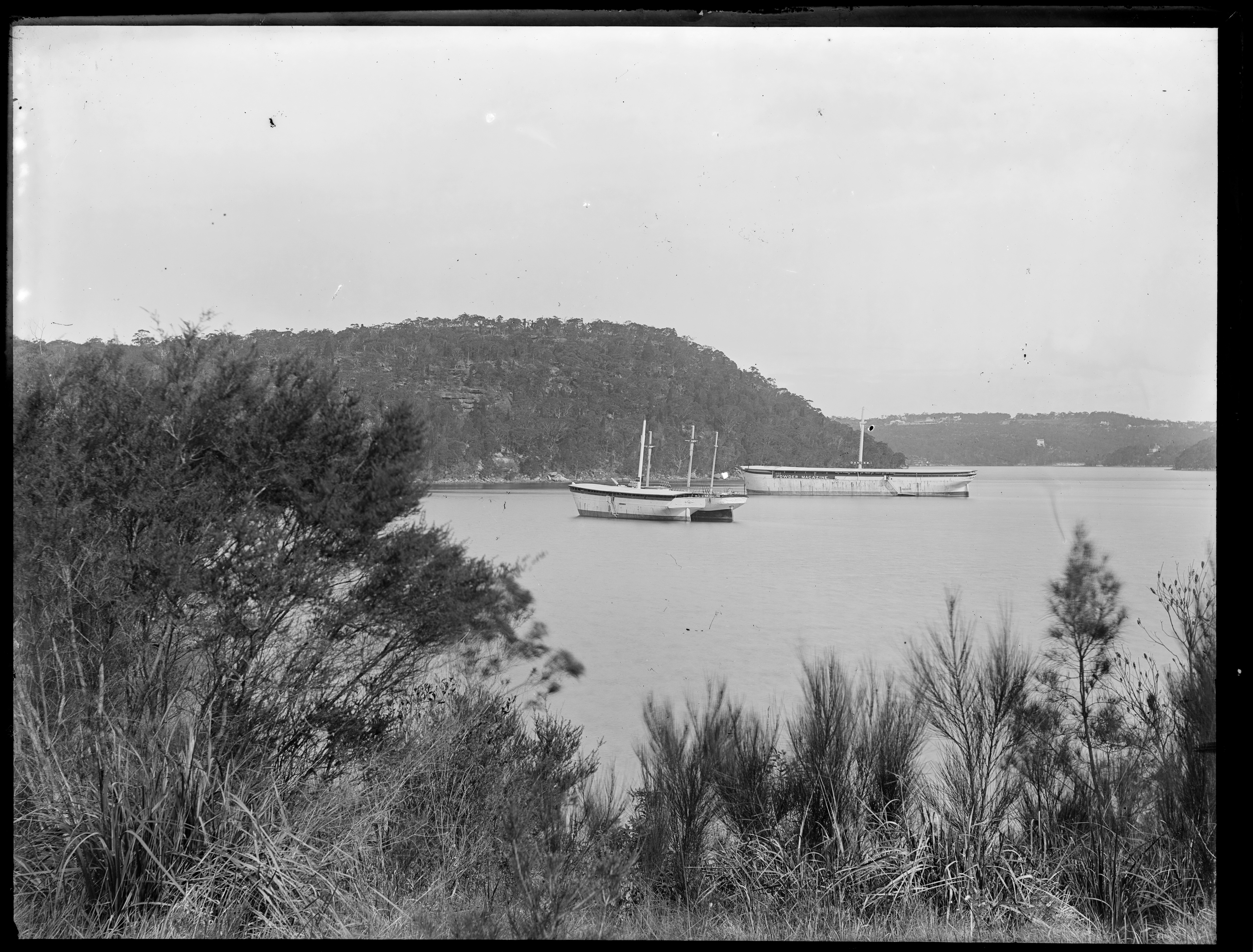
A total of 701 acres and 2 roads were allocated to for the storage facility. Work commenced in 1910 and in 1915 the new magazines at Bantry Bay were declared "Public Magazines".
Storage of Explosives.
NEW MAGAZINES TO BE BUILT. ON THE SHORES OF BANTRY BAY. AN END TO THE POWDERHULKS.
For years past objects of interest to the excursionists who have visited Middle Harbor on Saturdays, Sundays, and holidays have been the three powder hulks which have lain in one of the most picturesque of its bays. The days of the bulks, however, are numbered, for they are to be replaced by up-to-d2te magazines built into the hillside on the shores of Bantry Bay.
The requirements or the Mercantile Explosives Department have' for some time demanded that the magazine arrangements should be entirely remodelled and modernised, so as to provide an up-to-date system of staring explosives for the commercial use of the country. With that end in view, it is proposed, as stated, to abandon the use of the hulks now lying near the spot known as Balgowlah, at Middle Harbor, and steps were taken recently to secure a sufficient area of land on the western side of the upper reach of Bantry Bay on which to construct a series of magazines and wharfage facilities for loading and unloading.
The scheme provides for sinking into the rock-face of the cliff a series of magazines, each of which will contain a chamber, built and fitted with all modern appliances and construction, and each be so. shielded by the embrasure as to minimise the effect of any accidental explosion. That Is to say, they will be so built that should one of them explode it will not affect any of the others. Each magazine will contain a much smaller quantity of explosives than is at present sometimes stored on one hulk, which is said to reach up to as much as 600 tons.
The design provides for nine of these magazines, with direct access to wharfage extending along the whole sea-wall frontage of about 1500ft. In the centre of the schema, and on the projecting point where there is a sufficiency of deep water, will be erected sheds and a commodious wharf, suitable for lighters and other vessels of fairly deep draft to load and unload at the -old picnicking grounds of the Sydney Ferries Company, Limited, on the opposite shore of the bay, is also, it is stated, being resumed for residential purposes in connection with the staff and caretakers. The establishment is to be exceptionally complete, and is designed fully up to the growing requirements of the city and the State. Besides the magazine chambers there will also be a testing house.
A contract has been entered into with Mr. F. J. Cornwell, of Ashfield, for £7634, for the construction of the preliminary earthworks, rock-cutting, and sea-wall. Tenders will be Invited In due course for 'the erection of the buildings and wharf. There will be tramways to connect up the whole of the establishment, these being of a design suitable for magazine purposes. Storage of Explosives. (1910, August 31). Evening News (Sydney, NSW : 1869 - 1931), p. 7. Retrieved from http://nla.gov.au/nla.news-article115260627
Bantry Bay powder magazines.
Powder magazines are to be erected at Bantry Bay for the use of the Explosives Department. They will consist of eight separate buildings for the storing of explosives, and a receiving and examining house. They are to be constructed of brick with iron roofs, and will be of special construction for reducing the temperature inside as much as possible without the aid of mechanical means. The buildings will be connected with tramways to facilitate the handling of materials. Up to the present the excavations for the various buildings construction of a portion of the concrete sea-wall wharf, and reclamation have been carried out. The total estimated cost of the work is approximately £18,000. BANTRY BAY POWDER MAGAZINES. (1912, March 26). The Daily Telegraph (Sydney, NSW : 1883 - 1930), p. 7. Retrieved from http://nla.gov.au/nla.news-article239148778
The Bantry Bay Complex was extremely well designed, with tram tracks linking the recessed nine magazines to the Major Receiving Magazine and wharves on the waterfront. This was a specialised industrial integrated complex designed for safe handling and cool storage of explosives. The main complex had magazines of different size and light variation in design detail but all with landing platform to a tramway in excavated rock, double brick walls, parquet flooring (except fourteen and sixteen) and roofs to lift off under impact of explosion and with in built cooling systems watered from a concrete dam. Some wharves are covered to minimise heat exposure. The shed had a door to the Harbour and a pontoon.
During its time of operation, the complex was a highly specialised and industrious port facility, utilising a variety of boats and specialist hand trolleys to transport goods between the boats and the magazines.
The magazines were operated on a commercial basis by the state government and used for receiving, storing and distributing explosives for civil and commercial purposes. The Bantry Bay complex supplied explosives for the large public works undertaken in the 1930s, including the Sydney Harbour Bridge, underground tunnels and railways in the city, and the Newcastle highway, along with serving an expanding mining industry.
During World War II the complex was operated by the Allied forces. By then it comprised various magazines where the explosives were received, sorted and stored as well as an office, two jetties, numerous sheds and testing laboratories. Up to 18 men were regularly employed there, but until residential buildings were constructed on the eastern side of the bay in the mid-1940s, officers had their quarters on the hulk Alacrity, moored nearby.
Bantry Bay's isolation led to a high degree of camaraderie and pride among the workers, reflected in the high standard of safety and the maintenance of the complex.
In the years after World War II increasing funding had to be allocated to repair and maintain the magazines and, with revenue falling, their future began to look grim. The final straw was changing technology – which led to transportation of explosives by train rather than water. The event of new technologies and resident pressure eventuated the official announcement of the closure of the Bantry Bay facility in June 1972. The Complex was closed in May 1974 and incorporated into the Davidson Park State Recreation Area.
In 1992 Davison State Recreation Area was subsequently incorporated into Garigal National Park.
Since operations ceased at Bantry Bay, the care and maintenance of the buildings has been a major problem. Shortly after being included in Garigal National Park, a major stabilisation program was undertaken on the western seawall, but there were insufficient funds to complete the work (NPWS, 1998). Most of the buildings are in relatively sound condition, but have been subject to vandalism, and most the fittings have been removed.
Sydney, 16th August, 1974.
APPOINTMENT OF TRUSTEE
IN pursuance of the provisions of section 37p of the Crown Lands Consolidation Act; 1913, the undermentioned Council is hereby appointed as sole trustee of the reserve hereinafter particularized.
T. L. LEWIS, Minister for Lands.
Land District—Metropolitan; Municipality—Manly
Reserve 89212 at Bantry Bay, Parish Manly Cove, County Cumberland, notified 14th August, 1969, for Public Recreation: The Council of the Municipality of Manly. Pks 66-3014. APPOINTMENT OF TRUSTEE (1974, August 16). Government Gazette of the State of New South Wales (Sydney, NSW : 1901 - 2001), p. 3202. Retrieved from http://nla.gov.au/nla.news-article220160037
The National Parks section of the Department of Environment developed a small walk-in picnic area on the eastern foreshore, but this site is little known and receives limited use. The bay itself is a popular destination and refuge for boats. However, the area's closure, difficult access and limited public knowledge have combined to maintain the explosives magazines' seclusion and isolation.
Bantry Bay remains a largely unknown part of Sydney, even though it is right in people's backyards. There is much more at stake than a glimpse into our past when we lose such places due to neglect.
Is it time for the picnic grounds or a museum to return to this place?
Are residents, the state and federal governments going to let this place go as well - or will there be some rage against this place going into that long good night?
Photos: from 'Sydney Harbour : views of Middle and North Harbour bays and foreshores, including Quarantine Station, North Head' DATE approximately 1870s , Mitchell Library, State Library of New South Wales. Dated by Alan Davies, State Library of New South Wales, Curator of Photographs, 2002. From album of photos some with stamp ""J.R. Clarke, Publisher & Importer of Photographs ... Sydney"" and some also with stamp ""J. Paine, photo, Sydney"" (note by Library Officer on reverse of mounts). Includes a series, probably taken by amateur photographers, showing their portable darkroom and boat:
1-3. Middle Harbour near Bantry Bay, 4. Untitled, similar view to No.1, 5-10. Downward from head of Middle Harbour, 11. Accross (sic) Middle Harbour, 12. Shingle splitting Middle Harbour, 13. Middle Harbour point near Willoughby Falls
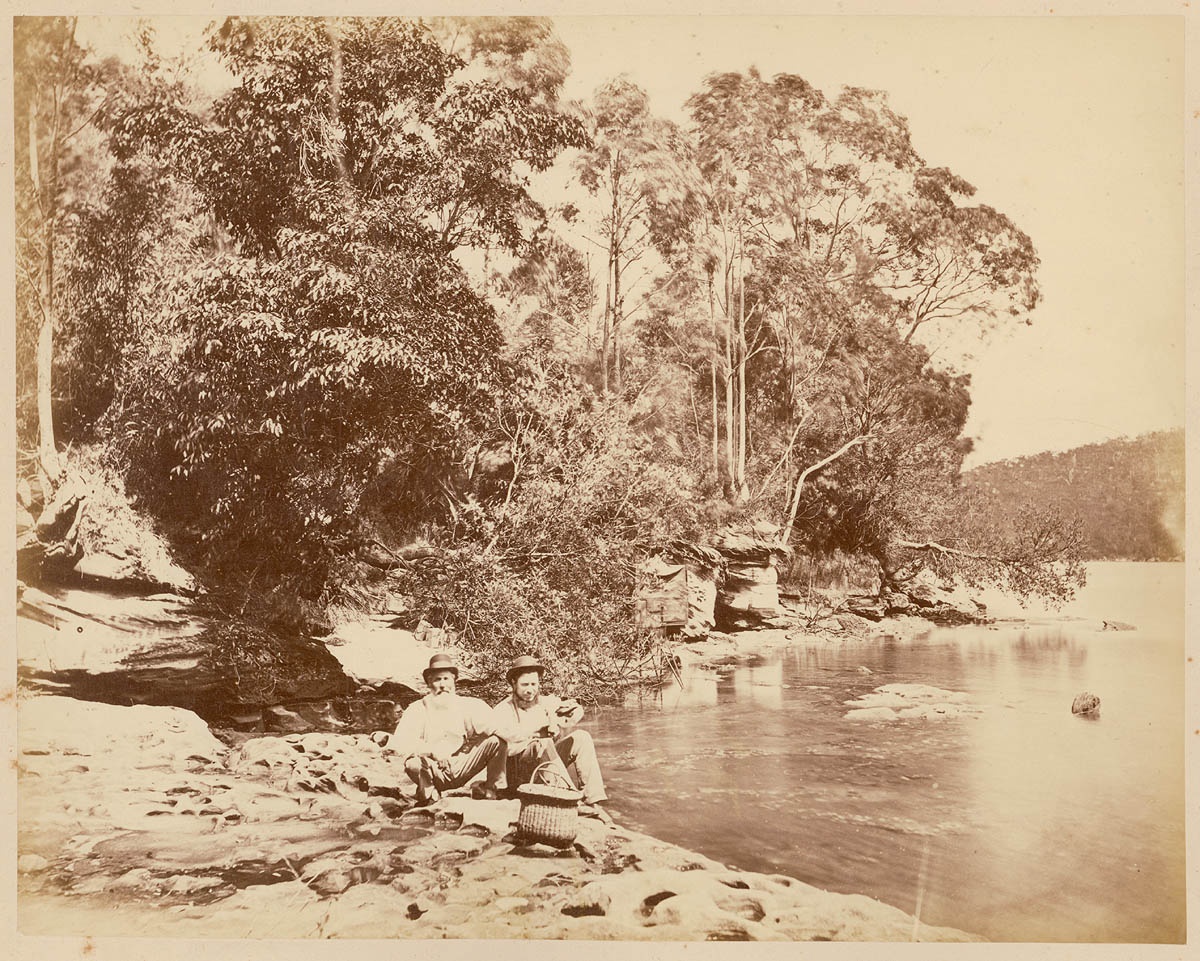
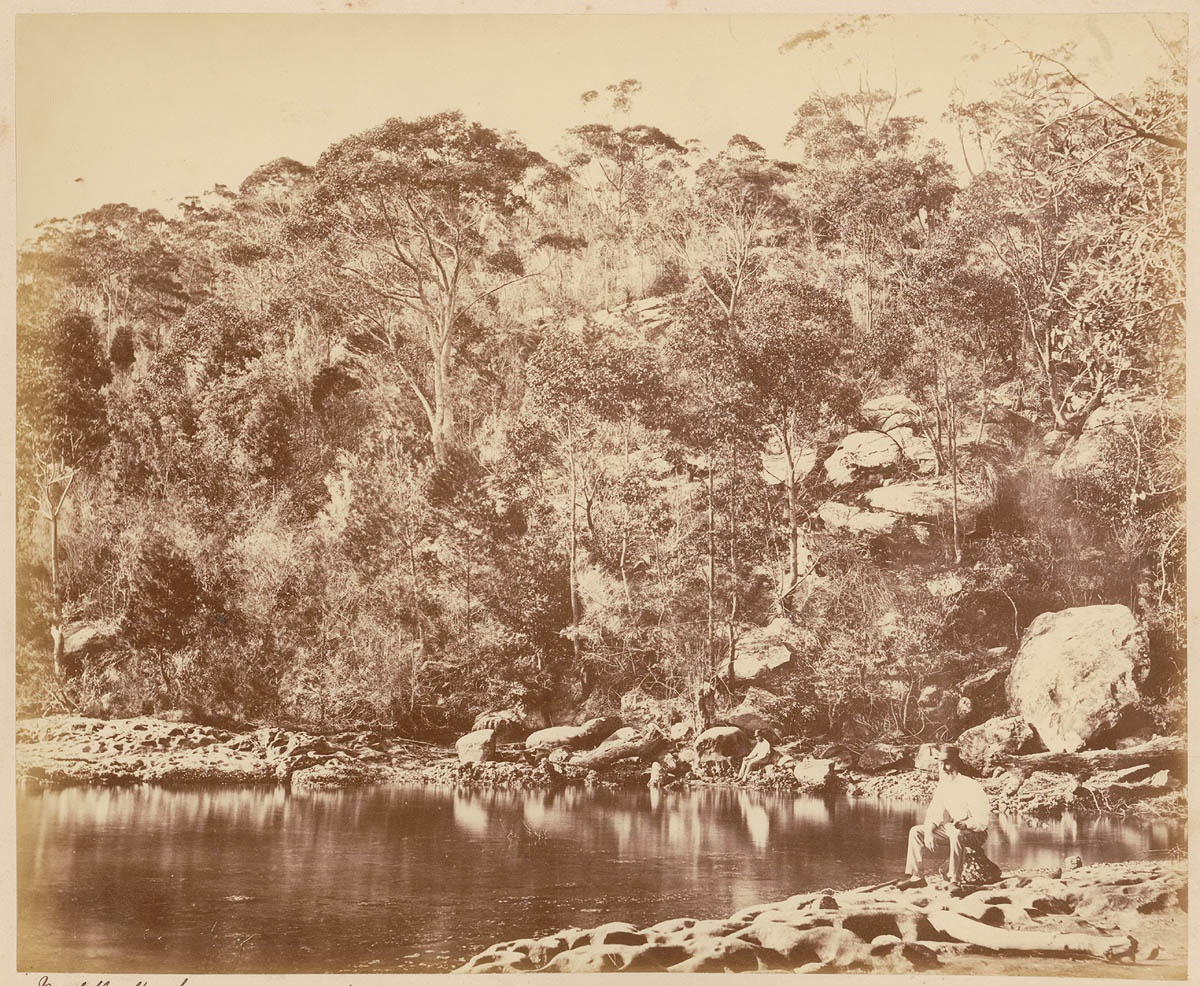
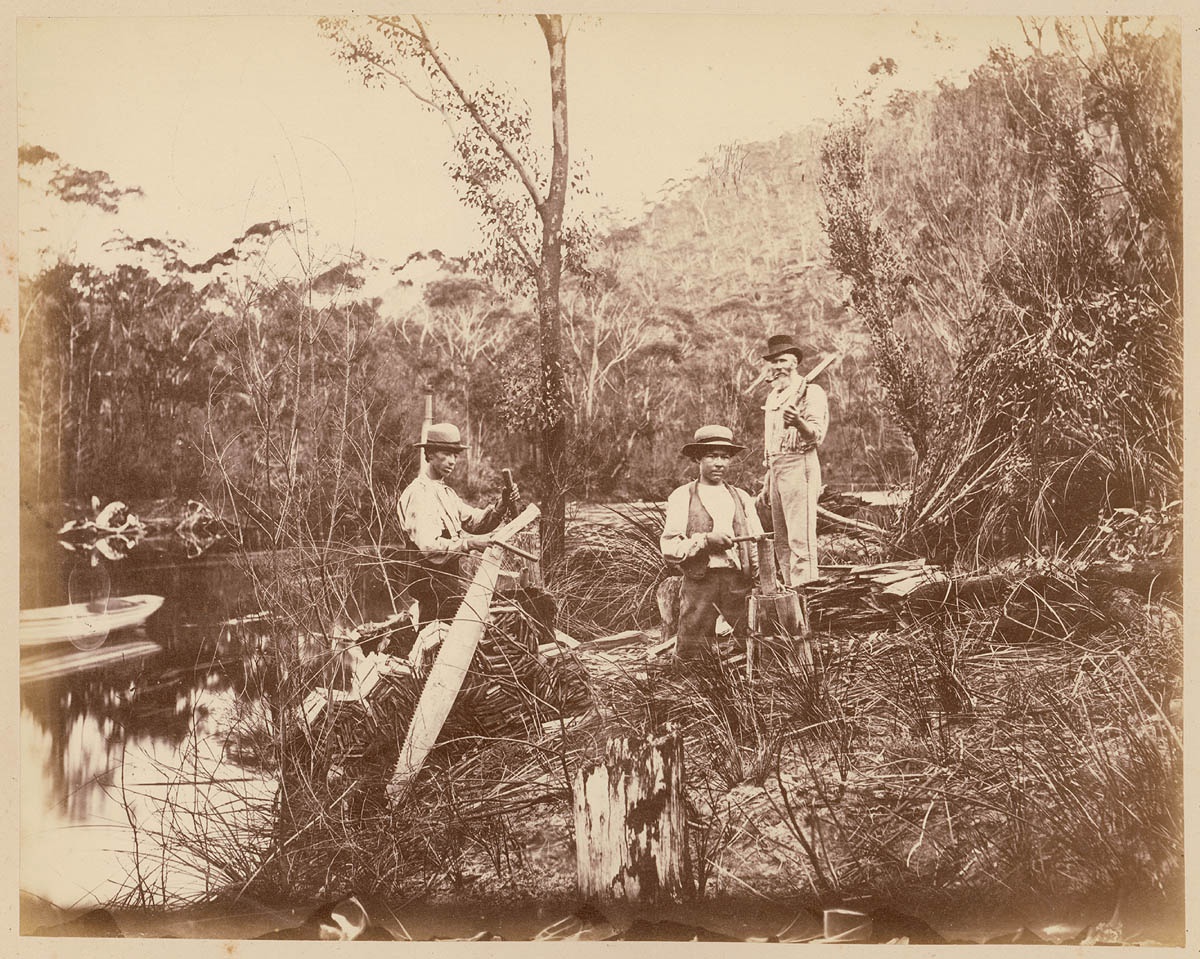
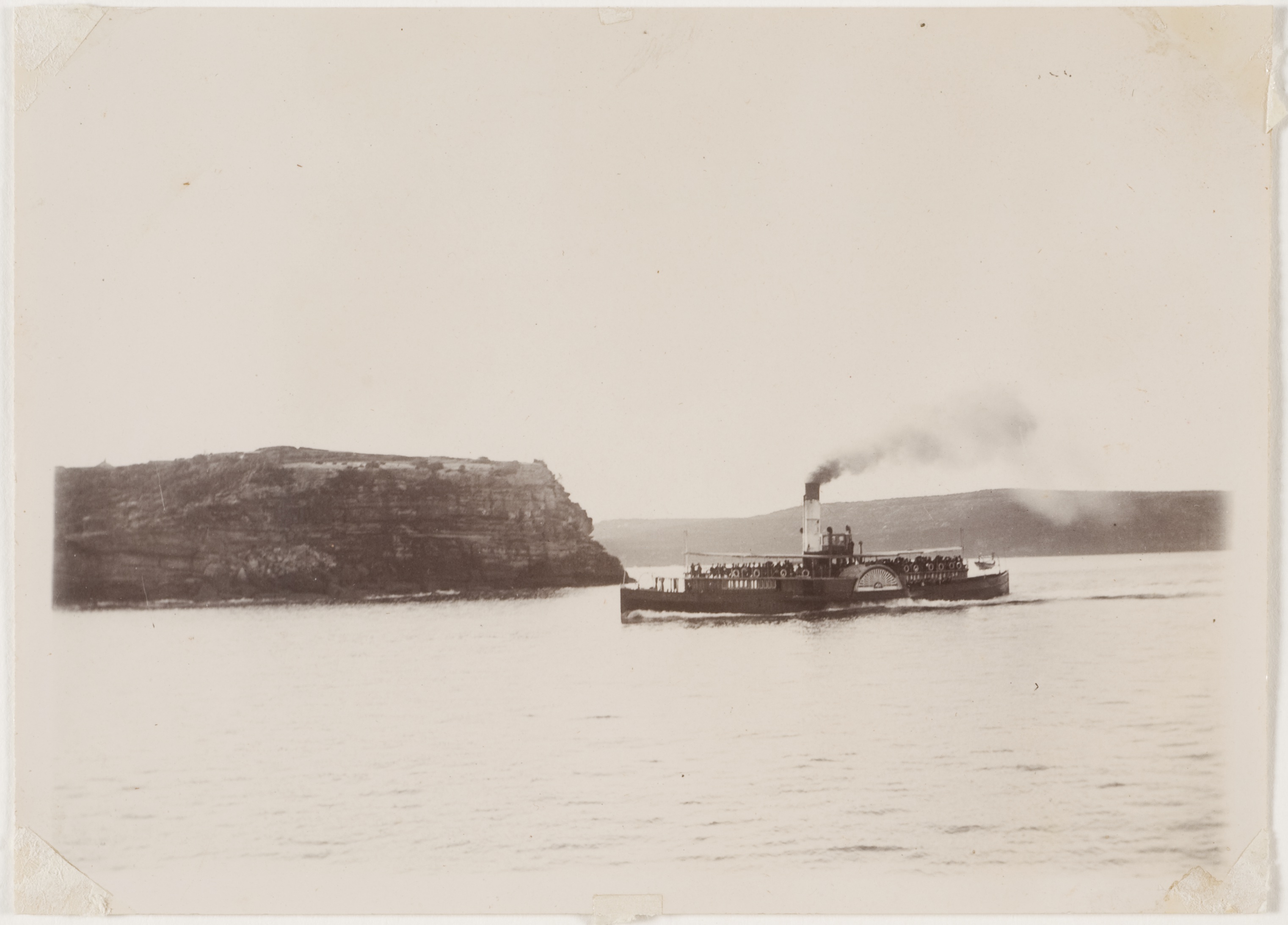
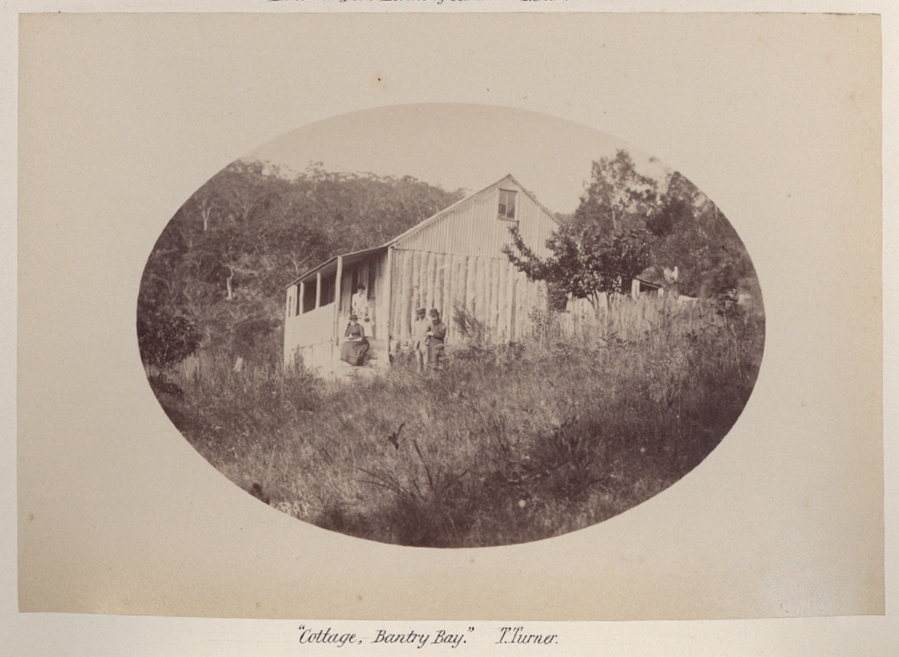
'Cottage by T Turner, Bantry Bay, circa 1888
Construction of Jetty for Powder Magazine in Bantry Bay DATE December 1912 and 9/1/1917 CALL NUMBERS Government Printing Office 1 - 24431, Original negatives held by State Archives & Records Authority of New South Wales:
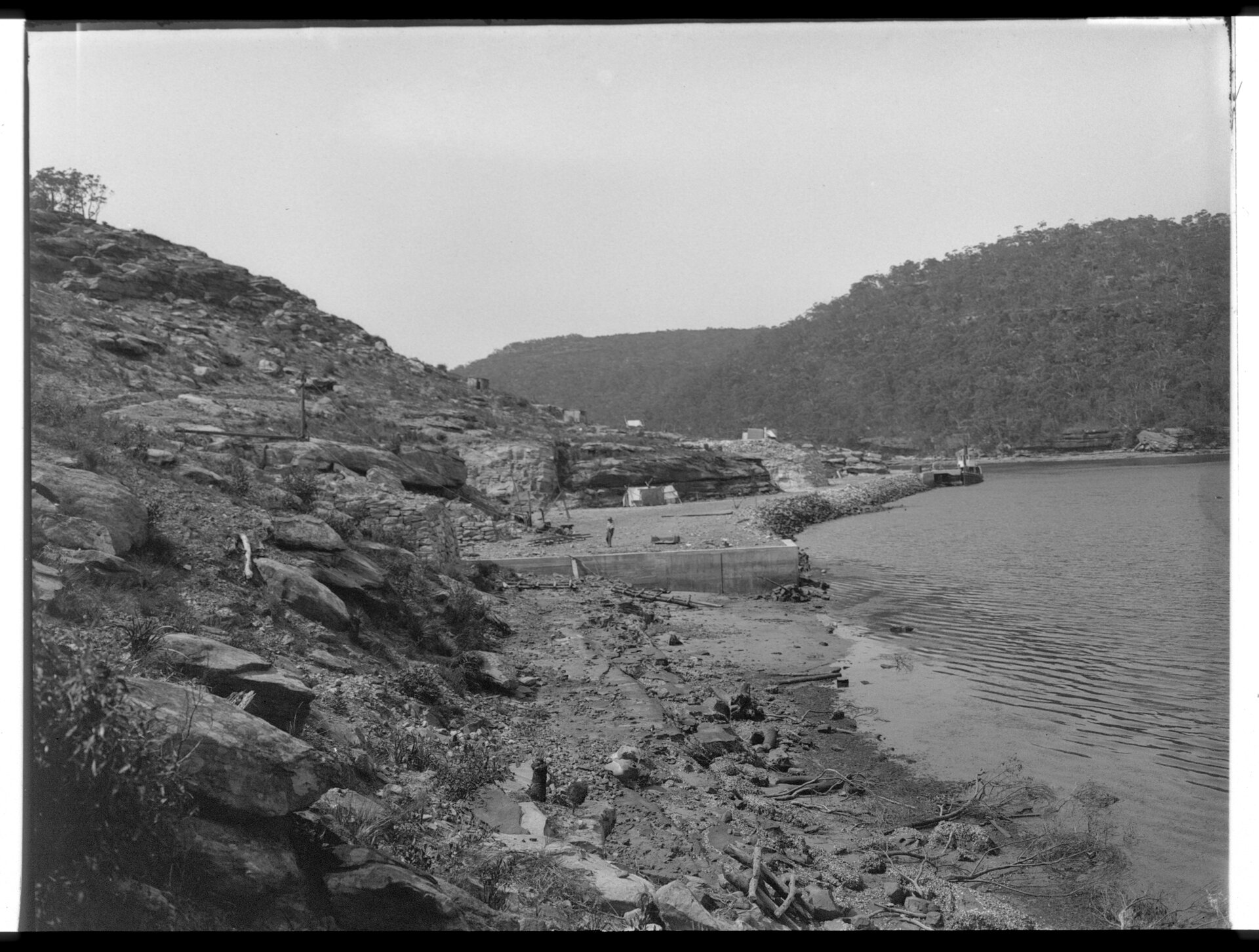
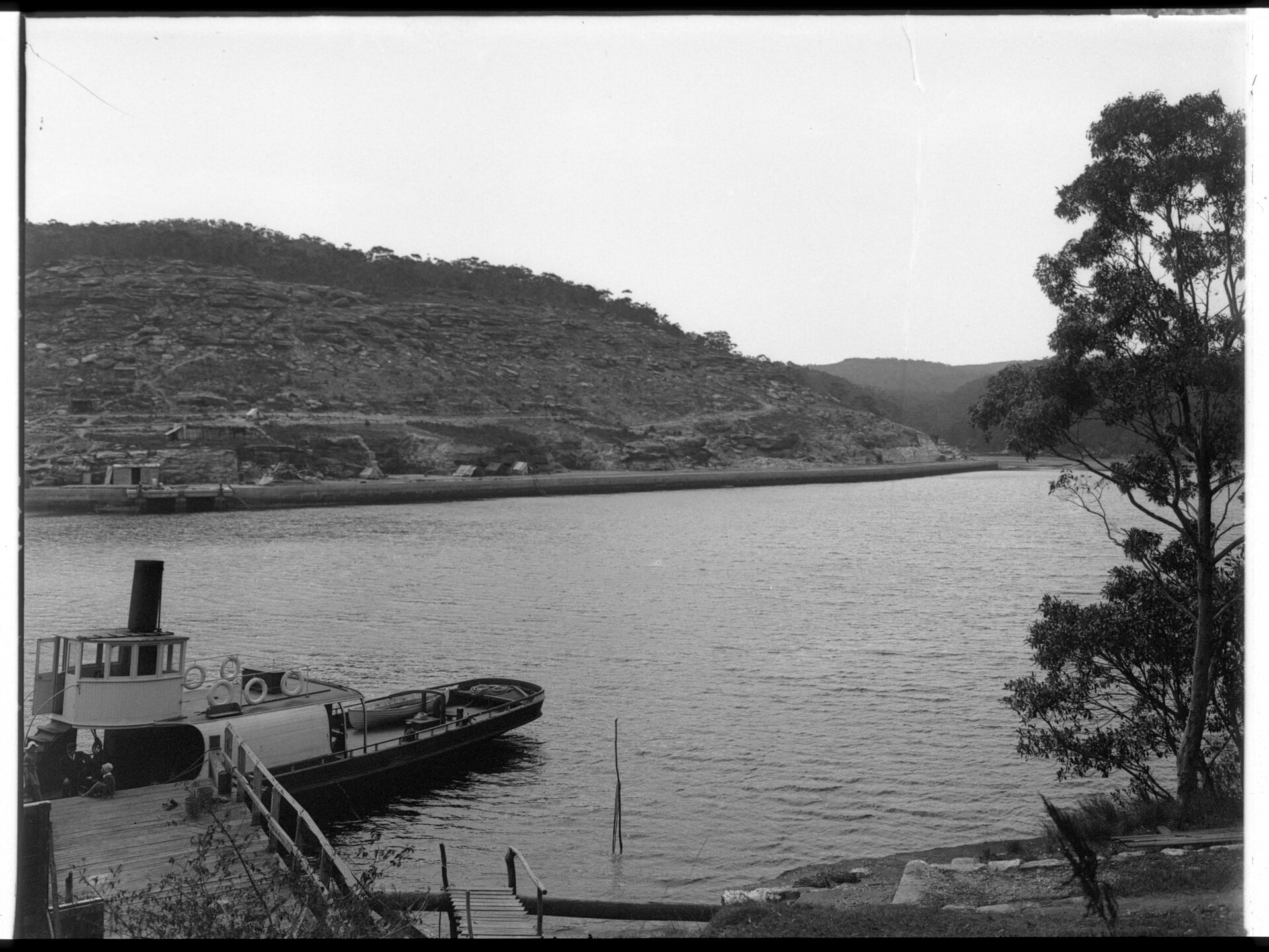
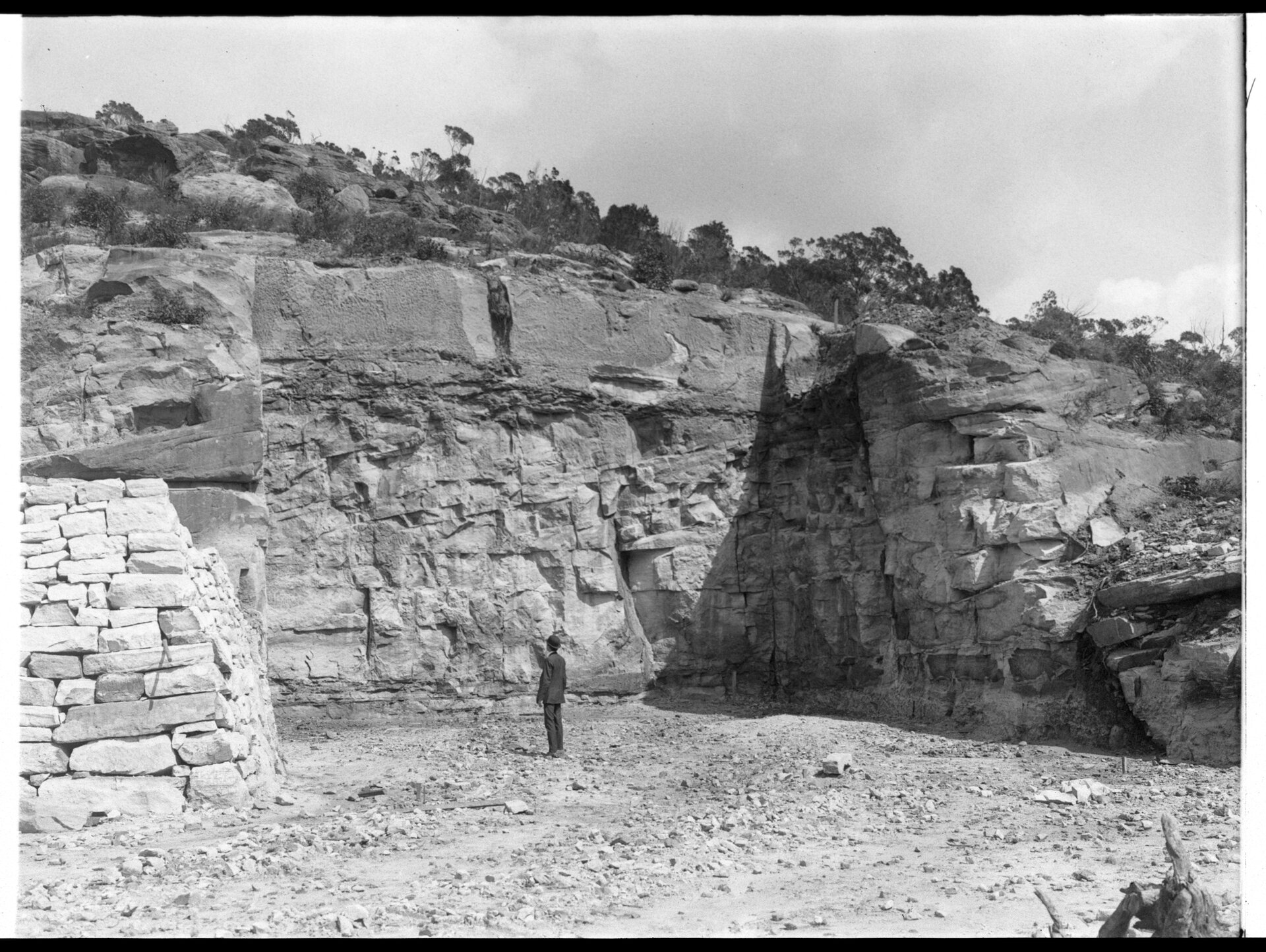
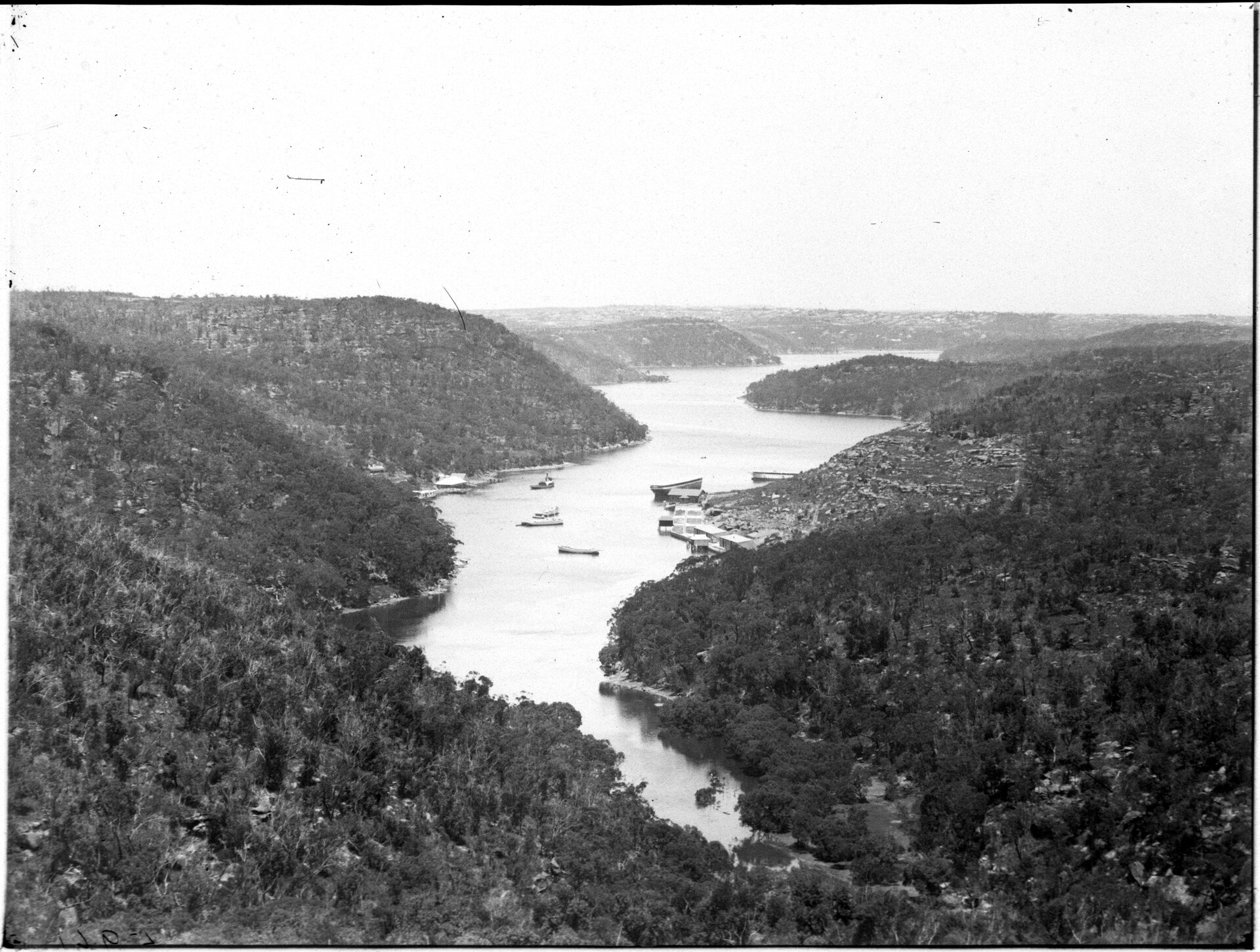
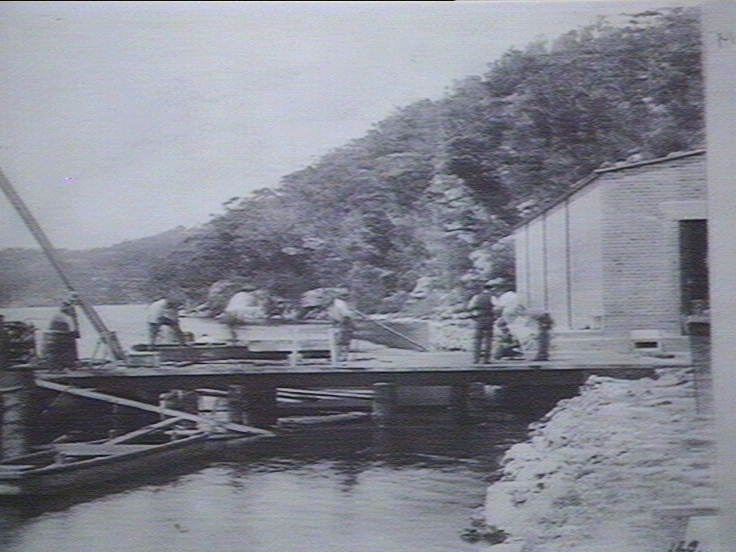
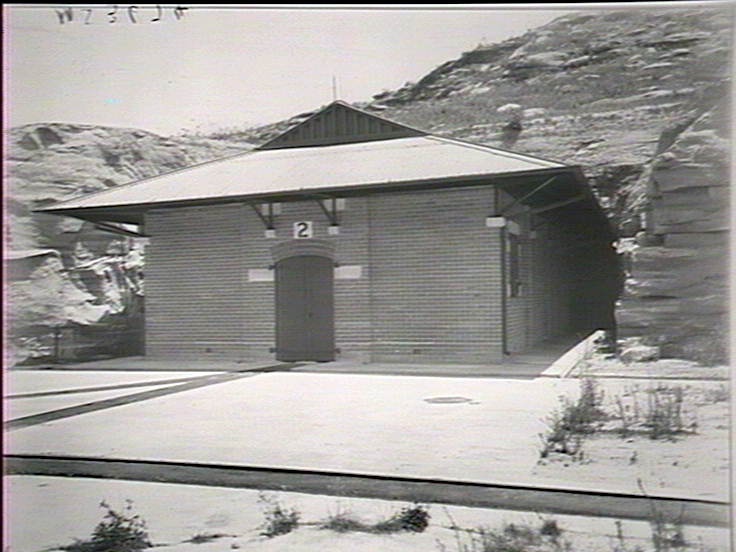
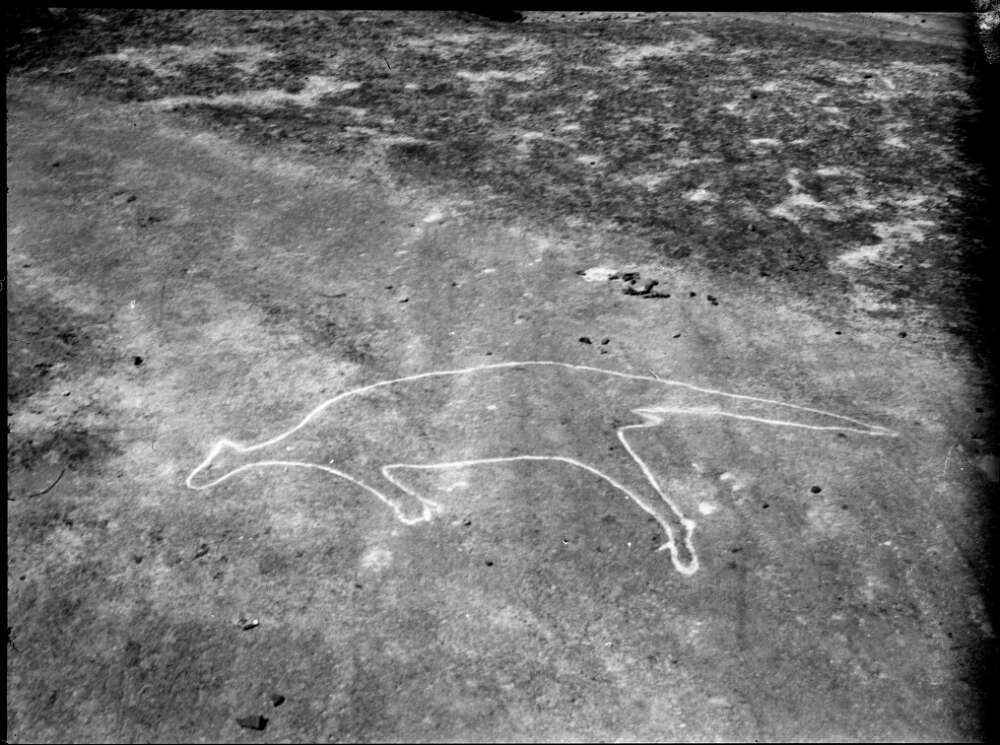
Rock carving of a kangaroo or wallaby, Bantry Bay, Middle Harbour, Sydney, ca. 1950, 3 [picture] / E.W. Searle Searle, E. W. (1945). Rock carving of a kangaroo or wallaby, Bantry Bay, Middle Harbour, Sydney, ca. 1950, 3 Retrieved from http://nla.gov.au/nla.obj-142035880
References - Extras
- Ten Years On ‘Hands Off Barrenjoey!’ Remains The Song - the 2023 Barrenjoey Rally
- TROVE National Library of Australia
- NSW Records & Archives
- Bantry Bay Conservation Management Plan (draft) Garigal National Park, NSW - NSW National Parks and Wildlife Service May 2002 Prepared for the National Parks and Wildlife Service by: Graham Brooks & Associates Taylor Brammer Landscape Architects Mary Dallas Consulting Archaeologists
- The First Royal Visitor To Australia: The Incident At Clontarf March 12th, 1868
- Clifton Gardens Mosman: An Eternal Green and Saltwater Space and Of Many Captains
- Prospector Powder Hulk At Towler’s Bay
- Bantry Bay Pleasure Grounds. MacRitchie, John, Bantry Bay, Dictionary of Sydney, 2008, http://dictionaryofsydney.org/entry/bantry_bay
- The Riddles of The Spit and Church Point: Sailors, Rowers, Builders
- The Macphersons Of Wharriewood: The William Joseph Macpherson Albums
ROCK CARVINGS.
A BANTRY BAY COLLECTION. SOME CURIOUS SIGNS.
There are many curious relies of the past customs of the aborigines still to be found within a small radius of the city, but these are fast disappearing owing to the disinclination of the authorities to preserve the records of a dying race. In the rock carvings of the aboriginals are undoubtedly records of lost practices and rites, but so meagre is the information concerning them and their meaning, that one is forced to the opinion that few people took the trouble to investigate the purport of what appear to be messages indelibly marked on the masses of sandstone around the harbor.
A quarter of a century ago one stumbled across these rude carvings on almost any elevated spot from which a commanding view was obtainable. To-day, however, they are mostly overgrown, or have been covered by roads and buildings. On the north side of the harbor some of the finest examples of the kind are to be found, in which fish form the major portion. But there are numerous designs of a comprehensive kind, no doubt carrying a meaning it would be interesting to decipher. The human form (male) is widely depleted in outline, and in most cases is to be seen carrying nulla, spear, womerah. boomerang, or shield. The attitudes are mostly warlike, and as a rule these figures are surrounded with representations of fish of every description. The whale and the shark are common among this miscellaneous collection, but native animals are lees familiar. Of the many traces of aboriginal rock carvings on the shores of Port Jackson, none equal in extent or completeness of detail those to be found on the heights above Bantry Bay, Middle Harbor. Many others of similar character have been discovered on the various headlands, of which may be mentioned a collection which was discovered during the erection of a battery at Middle Head. The find was a curious one as on making the necessary clearance of superficial soil and brushwood, the carvings were disclosed lying immediately under a few inches of vegetable mould. The carvings consisted of a whale about 30ft long and a jumping kangaroo, fish and other objects. But we will return to the Bantry Bay col-lection, which is visible just off the road lead-ing to the brick works in French's Forest, on a slightly inclined surface, on the eastern side of the right-hand arm of Bantry Bay. On a table of sandstone, the carvings are scattered over an area of about three chains by two. Un-fortunately, since the writer first saw the carv-ings, the roadway has passed over a portion, yet many are yet wholly visible, while some are partially so. The figures are represented in outline by a continuous indentation or groove averaging from an inch to an inch and a half in width, and from half-an-inch to one inch in depth. Some of the objects are depicted singly, white others form small groups representing compound subjects. Dr. Carroll, an authority on such carvings, was of opinion that all figures pointed in one direction, and faced the rising sun. This is
not the case at Bantry Bay, as they here point in all directions with a general westerly aspect. Among the prominent carvings is a kangaroo of huge dimensions with a spear protruding from its side. According to Dr. Car-roll, a speared kangaroo represents the chief warrior, who employed it as his totemic sign, the spear indicating his death in a similar manner. Next in review is the figure of a man alongside of whom is what is probably intended to be a porpoise, and what might also be taken to represent an eel, snake, or sea-serpent according to the aboriginal idea. This last is certainly one of the most interesting of the series. Close by is a carving resembling a shield or "mulga," but some people say it is a canoe. Then follows a compound idea in the form of a single combat between two warriors, one being armed with spears and shield, while the other is in such a position as to convey the idea that he has just thrown a boomerang. There is the figure of an animal that might be a dog close by, but apart, and within a short distance, is another compound idea. It represents three small fishes, all in single line, chasing what appears to be a catfish. Here we have a subject which might with reason be called the pursuit of a catfish. The largest and most imposing carving of the collection is a shark measuring 16ft 6in in length and about 7ft wide— a fish believed by Dr. Carroll to be a god-emblem among the aborigines. At its head stands a male figure with extended arms, the meaning of which is questionable. There are several other smaller sub-jects — some incomplete, but revealing the me- thod by which they were carved. These carvings, in a general way, no doubt possess the power of conveying ideas by a sort of picture writing common, long before Europeans made an encroachment on Australia. The question naturally arises whether the carvings are the work of the historical blacks now al-most extinct, or vestiges of a pre-existing sec-tion of the same race. The reticence of the black has always rendered the acquisition of reliable information concerning their arts and mysteries a very difficult task, and consequent-ly the myths and superstitions of the Australian aboriginal have been a source of speculation to all writers on the subject, but no doubt many of the signs bore peculiar and special reference to some of the ancient rites. According to Mr. Robt. Etheridge, jun. (the Curator of the Australian Museum), who has given the subject much thought and has writ-ten often on the matter, the areas on which the carvings are to be found formed portion of a "Bora" ground — a spot set apart for the performance of the initiatory mysteries attending the entrance of youths into manhood's estate. Anyhow the few remaining carvings should be preserved, and those at Bantry Bay could easily be fenced in, as they stand within the boundaries of a recreation reserve. ROCK CARVINGS. (1912, December 17). Evening News (Sydney, NSW : 1869 - 1931), p. 8. Retrieved from http://nla.gov.au/nla.news-article113775732
"The Watchman" Picnic
OUTING AT BANTRY BAY A Most Successful Gathering
The employees of "The Watchman" Newspaper, Ltd., now a formidable combination, inaugurated their first annual picnic on Saturday last with an excursion to Bantry Bay. The weather was ideal for such an outing, and everything combined to make the picnic a happy social event. Associated with the employees, who numbered twenty-eight, were their wives, families, sweethearts and friends, bringing the total number to about sixty.
The Balmain Company's motor steamer, "Lady Linda," was engaged for the day, and the party left town soon after nine o'clock. Arrived at Bantry Bay those who desired to do so were landed. The greater number elected to spend the morning cruising round the harbour.
Luncheon was served in the pavilion in Sargent's best style, and the highest praise • was bestowed upon the excellence of the menu and the courtesy and attention of the staff of waiters.
The chair was occupied by the Managing Editor (Mr. J. A. Packer), who was supported by the Rev. Dr. Dill Macky (Chairman of the Board) and Mrs. Dill Macky, the Rev. W. Woolls Rutledge, Mr. and Mrs. A. B. Pursell, Mr. and Mrs. Jas. Burns (Directors), Mr. G. H. Turner (Solicitor to the Company), the Rev. A. J. Waldock, the Rev. Henry Clark, Mr. R. B. Orchard, Mr. and Mrs. Boutclier, and Mr. S. Ridgway, who were present as invited guests. The Hon. W. H. Wilks, M.H.R., and a number of other friends who had been invited were unable to be present. After a most enjoyable meal a number of toasts were honoured, including that of "The King," the toasts being drunk in French non-intoxicating "Mas-de-la-Ville" Champagne.
The chairman said he was sorry in a sense that the time allotted for the toasts was so limited for he had never felt more like making a speech in his life. It was to be a day of pleasure however and not one for speech-making, and he would not rob them unnecessarily of the time allowed for the sports. He could not let the occasion-pass, however, without making a few remarks^ It was safe to say. that nobody who met with Dr. Dill Macky in the Scots' Church Manse just over six years ago to start "The Watchman" ever imagined that the day. was so near when a gathering of that nature would be held or be possible owing to the splendid growth of the concern. ("Hear, hear.") It was the employees' picnic. The idea of the gathering had originated with them—though he had the suspicion that it was Mr. Orchard's, example with his employees' that had fired their imagination—and the arrangements were entirely in their hands, with what satisfactory results they had ample evidences before them. The directors and visitors were the guests of the employees. It was a good sign when any social functions of that nature originated with the staff. When employers gave a picnic to their employees the invitation to attend became a command, but when the employees suggested such a gathering it was surely an indication of the harmonious relationship which existed between employer and employed. ("Hear, hear.") He was glad of the opportunity to bear testimony to the character, zeal and loyalty of the staff.
No firm in Sydney had more reason to be proud of its employees than "The Watchman." Limited, and they had the satisfaction of knowing, that from the youngest to the oldest, every emplovee was assisting in the great work they were trying to do for the cause they loved. (Applause).
There were difficulties to be faced : and fought. Nobody but those intimately associated with the management of the paper from its inception had any adequate idea of the fight that had been necessary to establish "The Watchman." They had been compelled to contest every inch of ground. There was much to discourage and disappoint. He frankly admitted that there had been times .... "The Watchman" Picnic (1908, April 16). Watchman (Sydney, NSW : 1902 - 1926), p. 8. Retrieved from http://nla.gov.au/nla.news-article115093075
How to Do Sydney.
SIGHTS OF INTEREST IN AND AROUND THE CITY AND THE BEST MEANS OP SEEING THEM.
V - MIDDLE HARBOR.
., (See illustrations on page 33.)
As the neighborhood of Sydney offers great varieties of scenery, so does its harbor assume very different aspects in different parts. Port Jackson is one of-the great commercial waterways of the world, and as such has, of course, -fallen greatly under the hand of man, who makes his presence, seen , in reclamation and wharf building and all the other changes from the state of nature needed to flt the port for shipping purposes. On : the Parramatta and Lane Cove Rivers again we see another effect of man's power over nature In the conversion of the bush to fruitful orchards and pleasant residential sites. But in Middle ? Harbor we have nature unadorned, or almost so,
over the greater part of its area, and it thus possesses attractions no longer felt in exploring the other parts of Sydney Harbor, which from their proximity to the city have earlier fallen under the influence of the utilitarian spirit of the age. It's lake-like character also differentiates it from Port Jackson or North Harbor, and it has other special features that render it well worthy of having a day devoted to it, even in the course of a short stay in Sydney.
BY STEAMER TO MIDDLE HARBOR.
On Sundays and holidays steamers run at frequent intervals from Circular Quay, conveying '. passengers to Clontarf, Balmoral, Pearl Bay, the Spit, Flat Rock, and Bantry Bay, and for those who cannot spare a whole day, or who do not care for boating, this is the best way of seeing some part, at least, of its beauties. The run down the harbor reveals the same beauties as I noted in the Watson's Bay trip; but we now get a. closer view of the northern shore, Bradley's Head, Chowder Bay, and the fortifications on George's Head and Middle Head. Rounding this last, we come to Balmoral Beach, a delightful picnic place, especially if the party includes children, for whom it forms an ideal playground. The beach is extensive, and is backed by steep hills, which make it a delightfully sheltered spot in) winter time, when
the westerly winds are blowing, and the trees give grateful shade in the summer heat, and allow of lunch being-partaken of in comfort. For the convenience of those who don't care about the bother of boiling their own 'billy hot water is procurable, and there are also excellent swimming baths, wherein a refreshing dip may be enjoyed. Balmoral is easily accessible by the Mosman or Spit tram from Milson's Point or Mosman's Bay; and, in addition to the pleasure of the trip across the harbor, the scenery from the Military-road is exceptionally fine. I should recommend visitors to Balmoral from town to go via Milson's Point, and return by the Mosman's steamer, or on a Sunday or holiday advantage may be taken of the Middle Harbor boat.
CLONTARF, THE SPIT, AND PEARL BAY.
Opposite Balmoral lies Grotto Point, and a little further on is Clontarf- memorable as the scene of the attempt on the life of the late Duke of Edinburgh while present at a charitable picnic in the grounds at which the steamer lands her passengers. Clontarf is one of the favorite pleasure grounds of Sydney, and is in great request for public and private picnics. Rounding the Spit, along which a tramway has been recently opened, and from which a Government steam punt conveys passengers and vehicles to the Manly road on the other side, the steamer calls next at Pearl Bay, another pleasure garden provided by private enterprise for the public benefit; Thence bur course lies northwards across the mouth of Long Bay, past Sailor Bay on the left and the bold eminence of the Bluff on the right, past the powder hulks moored here for the storage of explosives, and the double inlet of Sugarloaf Bay, to the steamer's last calling places--Bantry Bay and Flat Rock.
WILD FLOWERS, FERNS,- AND OYSTERS.
Those of the passengers who do not come merely for the steamer trip, to enjoy the fresh air and fine-scenery, but arrive by an early boat to p. ss the day ashore and remain in the afternoon, spend their, time-in collecting the oysters that are still found in fair numbers, though of small size, on the rocks, or in gathering the wild flowers that in spite of adverse conditions are still to b3 found here. The nature of the country is such that the movements of those landed here are some-what restricted, as the foreshores are rocky at the entrance of Main Arm, and the hills steep and difficult to climb, something in the natura of the South African kopjes, with which the war has made us familiar. But those who are not daunted by a "stiff and somewhat rough climb will be amply rewarded by the views to be obtained from the heights, and fern lovers will be delighted at the treasures revealed by a patient exploration of any of the little gullies. Ferns and mosses do net obtrude themselves on the notice of the casual observer as do the brilliant flowering plants, and, hence the unobservant may scramble up a stoney gully, finding no reward for their pains, but the exercise involved, while a careful search would reveal many charming specimens of various ferns, lichens, and mosses. It is much to be regretted that with the advent of easier means of communication this part of Middle Harbor has already suffered much in the way of injury to the flora, and the destruction of its natural beauties at the hands of thoughtless and destructive visitors.
WANTON DESTRUCTION OF FLOWERING PLANTS.
It is pitiful in spring time to see the masses of wild flowers torn up by people who probably carry them for an hour or two, and then, finding them an encumbrance, cast them away. Many such discarded bunches may be seen on the tracks around the shores and floating on the waters of the harbor on any Sunday or holiday, and I am sure that in many cases such vandalism is only the result of ignorance and … of the nature of the plants and their capabilities for adornment, and thoughtlessness as to the means by which they are obtained. Misled by the attractive bunches of wild flowers offered for sale In our streets, unthinking people imagine they have only to pull the same flowers to produce a similarly happy effect. But the professional flower gatherer knows when and where to go for the best specimens of the plants he wants, while the chance visitor takes what comes most readily to hand, and, moreover, experience has taught the former that care in gathering is necessary to preservation for any length of time; while the latter thinks it enough to tear them up anyhow. As many of them are shallow-rooted and very easily detachable from the sandy soil, the result is that when he wishes only the blossoms, he pulls up roots and all, and this helps in-the extinction of our wild flowers.
Very few of our native flowers last well in water; very few are easily capable of artificial cultivation, and all are undoubtedly seen to best advantage in their native surroundings. Take them from the hungry, rocky land where it seems marvellous that anything should ever flower, and transplant them to a rich garden soil. They resent the transfer, wither and die. I would ask every visitor, then, to bear in mind these two points-the quickness with which most of these lovely blossoms fade, and the readiness with which their Toots leave the soil-and if he still desires to take some home with him, to select them! and gather them in such a way as not to leave for his successors a wilderness, where Nature had planted for him a garden.
THE MIDDLE HARBOR PINE.
Conspicuous among the trees around Middle Harbor, on account of the exceptional darkness of its foliage, is the Middle Harbor pine, which stands out in pleasing contrast, of color and contour, to the trees around. It is said to be peculiar to this part, and hence its local name.
But it, along with the other timber near the foreshores, suffers equally with the flowers, though from another reason. Parties of inexperienced youth let loose in these solitudes, proceed to pull or cut down saplings for ridge poles for their tents, and all sorts of timber for their fires. Plenty of dry wood is available, but they seem to prefer showing their ignorance by trying what is green, and full of sap, and thus are they slowly, but surely, denuding the foreshore heights, which, unless measures are taken to preserve them, will in the course of a few years be universally bare and unsightly, as they already are in several places most frequented.
PRESERVATION AND ENHANCEMENT OF NATURAL 'BEAUTIES.
- I think it is the duty of the Government, on behalf of the public, ana of the private owners in .their own interests, to put a stop to this, and I may perhaps be allowed to make one or two suggestions. The great extent of Middle Harbor makes.
it rather an extensive beat for a ranger, but it is to be remembered that camps are pitched on the foreshores in most oases, and are (therefore easily visited by water. With a light draught oil or electric launch, a good patrol could be kept up, and the mere fact of someone being on the lookout would act as a deterrent. Of course I don't mean for a moment -that campers should be interfered with in their reasonable enjoyment, I only protest against wanton and wasteful destruction, which the genuine and experienced camper does not commit. Something might be done by erecting fireplaces, such as are maintained at the mountain resorts, with wood ready for the fire, and these could be placed at spots easily in sight of the patrol. It might be made compulsory for camping parties to take their ridge poles, etc., with them; otherwise, as the numbers increase with years, the demand for suitable (timber will practically clear the land. The expenses of supervision might well be met by a small tax-something like the 'Dog Tax-on pleasure boats, each boat to have a receipt for same-'say a medal numbered token-to be produced on demand of the authorities. Penalties should be inflicted for breeches of the rules, and the amount credited to the fund. I don't know whether the Harbor Commissioners would consider such matters within their purview, but I earnestly commend the question to the consideration of all Interested in the preservation in its natural state of one of the most romantically beautiful spots in the neighborhood of Sydney.
' MAIN ARM.
The trip by steamer to the points mentioned above is full of interest, and well worth taking, but he who has seen Middle Harbor in this way alone bas missed its most charming parts. Steamboat proprietors may advertise trips to the head of 'Middle Harbor, 'but natural obstacles prevent it being more than a mere façon de parler like that which makes every member of the 'Legislature the "honorable" member, or, if he happened to be in the army or navy, "the honorable and gallant." To see Middle Harbor properly is to go to the top of -Main -Arm, and this can only he done in a skiff, and as it l3 (to my mind) one of the most beautiful of our water excursions, I propose to show how best to do it. Until lately, the best plan was to proceed by boat to Milson's Point, thence by tram to OEWdge-street, and take a conveyance to Polly Point, or continue in (Mosman tram to Alfred-street, and walk to the point, where suitable boats may be had at a moderate rate. This route may »till be followed, hut since the tram how runs to the Spit, O should recommend the Intending explorer to proceed thither and make the ¡boatsheds at the Spit the starting point of his water journey. On the run along Military-road, fine views of the city and harbor are to be had, and the windings of the picturesque road, followed by the latest addition to our tramlines, present a view of harbor scenery such as is probably to be seen from no other tramline in the world. Those who are interested; in the development of communication may profitably contrast the old Spit-road-'until recent years the only means of reaching the Spit-with the modern road, along which the tramline winds. -, The difference-in grade is very evident, and suggests, on a small scale, the improvements recently effected in our line over the Blue Mountains, recalling, too, perhaps, the remark attributed to the American attache in South Africa in reference to frontal attacks. Was there no way round?
HOW TO ENSURE A PLEASURABLE DAY.
Boats may be procured at the Spit, and the number and nature of the party must regulate the choice. The main points to be remembered are not to take an unnecessarily heavy load-but, to the credit of the boat proprietors, be it said, there are few who will allow this to be done-not to take more in the way of "tucker" than is needed, to take a kellick and stern line, and a good supply. of fresh water. ....
Now and then a group of bathers may be seen, for above the flats Jack Shark is disregarded, although there is always a certain amount of risk, and it seems a pity that better provision in this way is not made. It would cost very little to fence off some of the many available spots, and thus give safety to the bather while avoiding; all risk of offending feminine susceptibility. This would make Main Arm much more pleasant for all and surely might be managed, in connection with some such supervision as I have suggested above. When progress associations and Government can do so much for resorts much further afield, something should be done for the places at our very doors.
THE UPPER PART OF MAIN ARM.
The scenery changes as I have said from lake to river, and gradually the river narrows to a creek, but always of most beautiful surroundings. To describe the beauty of particular portions is beyond my power-they must be seen to be appreciated. Here we have the true primeval solitude, and it is hard to realise amid such scenes that we are close to a mighty city such .as that we have just left. For anything that our surroundings tell us, we might be hundreds of miles from any civilised habitation, and herein lies the peculiar charm of this Main Arm. It is absolutely and entirely natural, and if propitious fate enables us to dally long enough at the head to make the return trip by moonlight, we rn av hear at sundown the notes of birds we should never hope to And so close to town; while the scene on the return journey is beautiful in the extreme. The moonlight softens the rugged features of the scenery and conceals the dull hue of the vegetation, while
In heaven the stars about the moon
....
AT THE HEAD OF NAVIGATION.
The head waters of Middle Harbor lie between the ridge along which runs the North Shore railway, and the watershed between it and the coast, and although small and rather hard of access, some of the pools are of extreme and unexpected beauty. At the head of navigation for rowing boats, where we camp for dinner or tea, as the case may. be, and the-tide and time direct, there is a fine fresh water ''bogie hole," where a refreshing plunge may be indulged in. If time permits, I recommend the visitor to proceed some way up the gully-running the creek up towards the headwaters, and he will be surprised at the variety and wealth of : the vegetation. The return journey should be commenced in ample time to allow of the flats being crossed, otherwise a considerable distance will be added to the day's work, and enjoyment, perhaps, marred by overexertion. I mentioned a kellick and stern line as requisites for the journey. This is in case of a desire to halt by the way at any of the natural camping grounds. The merciful man is merciful to his boat-or to anotherfs-and the shores preserve their rocky and boulder strewn character in the upper as well as the lower part of Main Arm.
(To be continued.)
How to Do Sydney.-Middle Harbor.
(See letterpress on page 29.)
1:-NORTH HEAD, FROM THE MILITARY-ROAD, MIDDLE HEAD. 2.-THE BALANCING- ROCK. 3.-VIEW FROM THE EDINBURGH CASTLE ROCK.
4.-THE SPIT ROAD JUNCTION. 5.-THE SPIT. [ALL RIGHTS RESERVED.] (1900, December 22). Australian Town and Country Journal (Sydney, NSW : 1870 - 1919), p. 29. Retrieved from http://nla.gov.au/nla.news-article71387272
